Document Outline
- WM8569
- 24-bit, 192kHz Stereo CODEC with Volume Control
- DESCRIPTION
- FEATURES
- APPLICATIONS
- BLOCK DIAGRAM
- TABLE OF CONTENTS
- PIN CONFIGURATION
- ORDERING INFORMATION
- PIN DESCRIPTION
- ABSOLUTE MAXIMUM RATINGS
- RECOMMENDED OPERATING CONDITIONS
- ELECTRICAL CHARACTERISTICS
- MASTER CLOCK TIMING
- DIGITAL AUDIO INTERFACE Ö MASTER MODE
- DIGITAL AUDIO INTERFACE Ö SLAVE MODE
- MPU INTERFACE TIMING
- DEVICE DESCRIPTION
- INTRODUCTION
- AUDIO DATA SAMPLING RATES
- HARDWARE CONTROL MODES
- DIGITAL AUDIO INTERFACE
- POWERDOWN MODES
- ZERO DETECT
- SOFTWARE CONTROL INTERFACE OPERATION
- REGISTER MAP
- CONTROL INTERFACE REGISTERS
- DIGITAL FILTER CHARACTERISTICS
- DAC FILTER RESPONSES
- ADC FILTER RESPONSES
- ADC HIGH PASS FILTER
- DIGITAL DE-EMPHASIS CHARACTERISTICS
- APPLICATIONS INFORMATION
- RECOMMENDED EXTERNAL COMPONENTS
- RECOMMENDED EXTERNAL COMPONENTS VALUES
- SUGGESTED ANALOGUE LOW PASS POST DAC FILTERS
- PACKAGE DIMENSIONS
- IMPORTANT NOTICE
- ADDRESS:
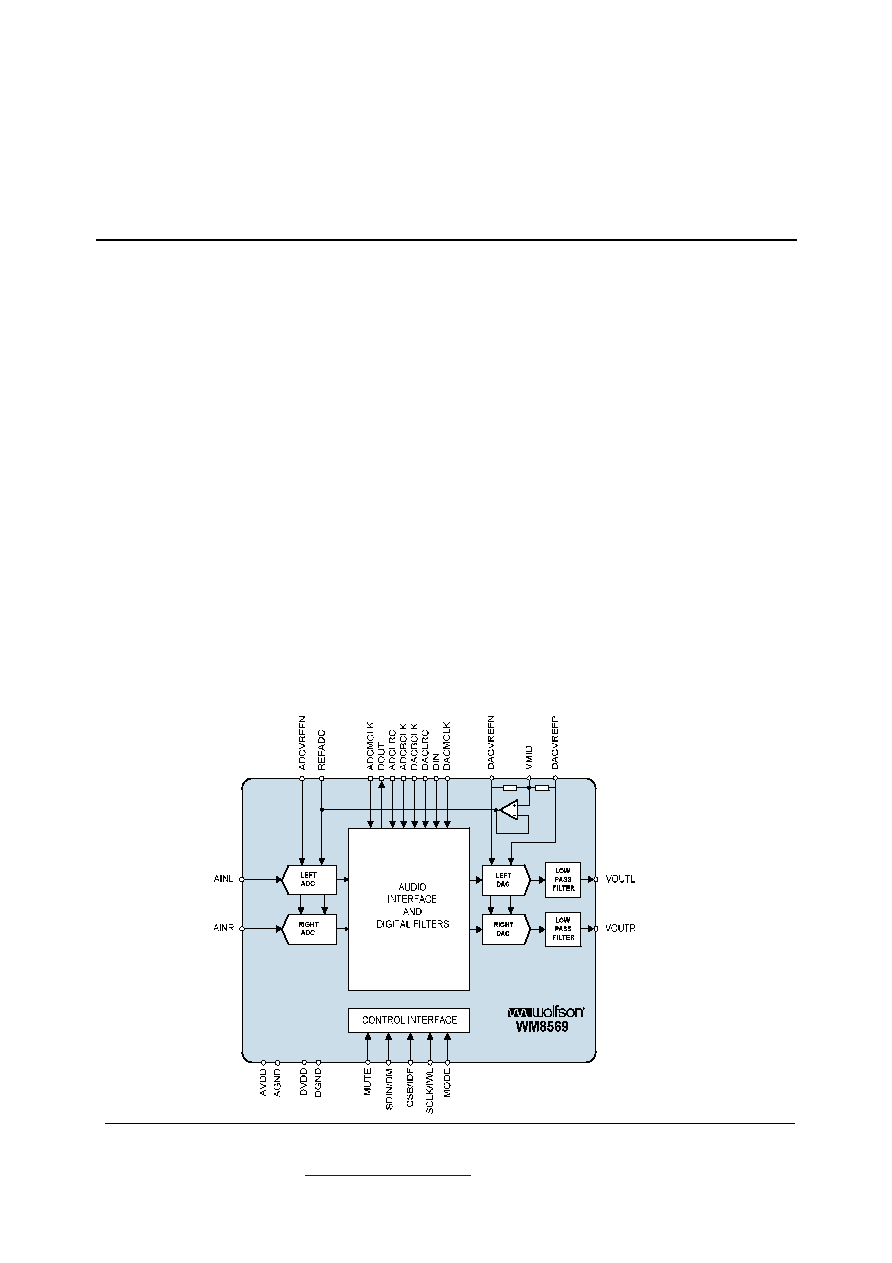
w
WM8569
24-bit, 192kHz Stereo CODEC with Volume Control
WOLFSON MICROELECTRONICS plc
To receive regular email updates, sign up
at
http://www.wolfsonmicro.com/enews/
Product Preview, December 2005, Rev 1.1
Copyright
2005 Wolfson Microelectronics plc
DESCRIPTION
The WM8569 is a stereo audio codec ideal for DVD, PVR,
LCD-TV and automotive applications. Independent ADC
and DAC clocking permits separate record and playback
sampling rates.
A stereo 24-bit multi-bit sigma delta DAC with oversampling
and digital interpolation filters provides the output signal.
Digital audio input word lengths from 16-24 bits and
sampling rates from 8kHz to 192kHz are supported.
A stereo 24-bit multi-bit sigma delta ADC is used. Digital
audio output word lengths from 16-24 bits and sampling
rates from 32kHz to 96kHz are supported. The DAC and
ADC support independent sampling rates.
The audio data interface supports I
2
S, left justified, right
justified and DSP digital audio formats.
The device is controlled via a 3-wire serial interface. The
interface provides access to all features including volume
controls, mutes, de-emphasis and power management
facilities. A hardware control interface allows access to a
limited feature set. The WM8569 is available in a 28-lead
SSOP.
FEATURES
∑
Audio Performance
-
103dB SNR (`A' weighted @ 48kHz) DAC
-
DAC Sampling Frequency: 8kHz ≠ 192kHz
-
100dB SNR (`A' weighted @ 48kHz) ADC
-
ADC Sampling Frequency: 32kHz ≠ 96kHz
∑
Independent Sampling Rates for ADC and DAC
∑
3-wire SPI Serial or Hardware Control Interface
∑
Audio Mute and De-Emphasis Functions
∑
Programmable Audio Data Interface Modes
-
16/20/24/32 bit Word Lengths
-
I
2
S, Left, Right Justified or DSP
∑
2.7V to 5.5V Analogue Supply
∑
2.7V to 3.6V Digital Supply
∑
28-lead SSOP Package
APPLICATIONS
∑ DVD Recorder
∑ Personal Video Recorder
∑ PC Sound Card
∑ Automotive Audio
∑ LCD-TV
BLOCK DIAGRAM

WM8569
Product Preview
w
PP Rev 1.1 December 2005
2
TABLE OF CONTENTS
DESCRIPTION .......................................................................................................1
FEATURES.............................................................................................................1
APPLICATIONS .....................................................................................................1
BLOCK DIAGRAM .................................................................................................1
TABLE OF CONTENTS .........................................................................................1
PIN CONFIGURATION...........................................................................................3
ORDERING INFORMATION ..................................................................................3
PIN DESCRIPTION ................................................................................................4
ABSOLUTE MAXIMUM RATINGS .........................................................................5
RECOMMENDED OPERATING CONDITIONS .....................................................6
ELECTRICAL CHARACTERISTICS ......................................................................6
TERMINOLOGY ............................................................................................................ 7
MASTER CLOCK TIMING ............................................................................................. 8
DIGITAL AUDIO INTERFACE ≠ MASTER MODE ......................................................... 8
DIGITAL AUDIO INTERFACE ≠ SLAVE MODE .......................................................... 10
MPU INTERFACE TIMING .......................................................................................... 12
DEVICE DESCRIPTION .......................................................................................13
INTRODUCTION ......................................................................................................... 13
AUDIO DATA SAMPLING RATES............................................................................... 13
HARDWARE CONTROL MODES ............................................................................... 14
DIGITAL AUDIO INTERFACE ..................................................................................... 16
POWERDOWN MODES ............................................................................................. 20
ZERO DETECT ........................................................................................................... 20
REGISTER MAP ......................................................................................................... 21
CONTROL INTERFACE REGISTERS ........................................................................ 22
DIGITAL FILTER CHARACTERISTICS ...............................................................30
DAC FILTER RESPONSES......................................................................................... 30
ADC FILTER RESPONSES......................................................................................... 31
ADC HIGH PASS FILTER........................................................................................... 31
DIGITAL DE-EMPHASIS CHARACTERISTICS........................................................... 31
APPLICATIONS INFORMATION .........................................................................33
RECOMMENDED EXTERNAL COMPONENTS VALUES ........................................... 33
SUGGESTED ANALOGUE LOW PASS POST DAC FILTERS ................................... 34
PACKAGE DIMENSIONS ....................................................................................35
IMPORTANT NOTICE ..........................................................................................36
ADDRESS: .................................................................................................................. 36

Product Preview
WM8569
w
PP Rev 1.1 December 2005
3
PIN CONFIGURATION
ORDERING INFORMATION
DEVICE
TEMPERATURE
RANGE
PACKAGE
MOISTURE
SENSITIVITY LEVEL
PEAK SOLDERING
TEMPERATURE
WM8569GEDS/V
-25 to +85
o
C
28-lead SSOP
(Pb-free)
MSL3
260
o
C
WM8569GEDS/RV
-25 to +85
o
C
28-lead SSOP
(Pb-free, tape
and reel)
MSL3
260
o
C
Note: Reel quantity = 2,000
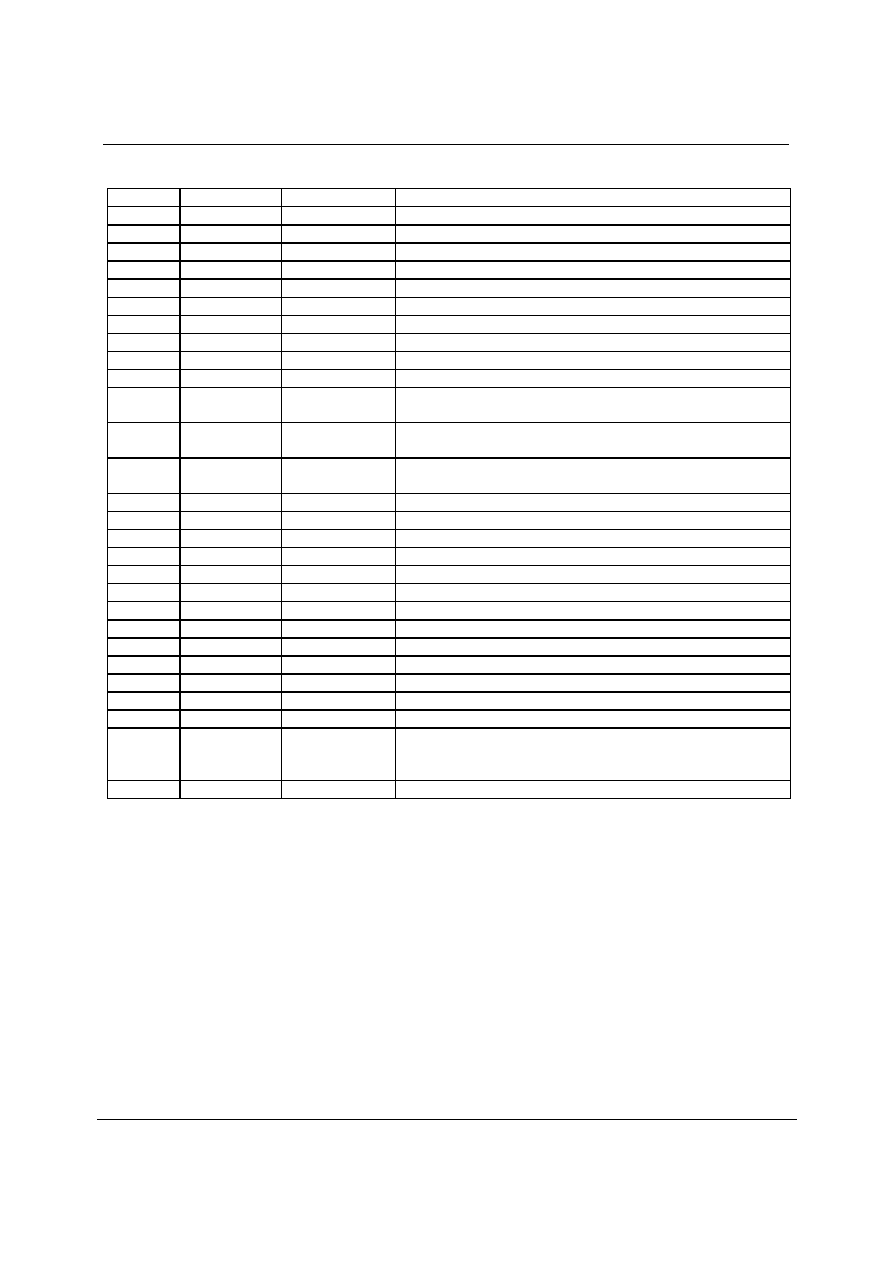
WM8569
Product Preview
w
PP Rev 1.1 December 2005
4
PIN DESCRIPTION
PIN
NAME
TYPE
DESCRIPTION
1
DACMCLK
Digital Input
Master DAC clock: 256fs, 384fs, 512fs or 768fs
2
ADCBCLK
Digital Input
ADC audio interface bit clock
3
DACBLCK
Digital Input/Output
DAC audio interface bit clock
4
ADCLRC
Digital Input/Output
ADC left/right word clock
5
DACLRC
Digital Input/Output
DAC left/right word clock
6
DVDD
Supply
Digital positive supply
7
DGND
Supply
Digital ground
8
DIN
Digital input
DAC data input
9
NC
No Connect
No Connect
10
DOUT
Digital output
ADC data output
11
CSB/IDF
Digital input
Software Mode: Serial control interface latch signal
Hardware Mode: Input audio data format
12
SCLK/IWL
Digital input
Software Mode: Serial control interface clock
Hardware Mode: Audio data input word length
13
SDIN/DM
Digital input
Software Mode: Serial control interface data
Hardware Mode: De-emphasis selection
14
MUTE
Digital input/output
DAC Zero Flag output or DAC mute input
15
REFADC
Analogue output
ADC reference buffer decoupling pin; 10uF external decoupling
16
ADCVREFN
Supply
ADC negative reference supply
17
DACVREFN
Supply
DAC negative reference supply
18
DACVREFP
Supply
DAC positive reference supply
19
VMID
Analogue output
Midrail divider decoupling pin; 10uF external decoupling
20
AINR
Analogue input
ADC right input
21
AINL
Analogue input
ADC left input
22
VOUTL
Analogue output
DAC left output
23
VOUTR
Analogue output
DAC right output
24
NC
No Connect
No Connect
25
AGND
Supply
Analogue negative supply and substrate connection
26
AVDD
Supply
Analogue positive supply
27
MODE
Digital Input
Control format selection:
0 = Software mode
1 = Hardware mode
28
ADCMCLK
Digital Input
Master ADC clock: 256fs, 384fs, 512fs or 768fs
Note: Digital input pins have Schmitt trigger input buffers.
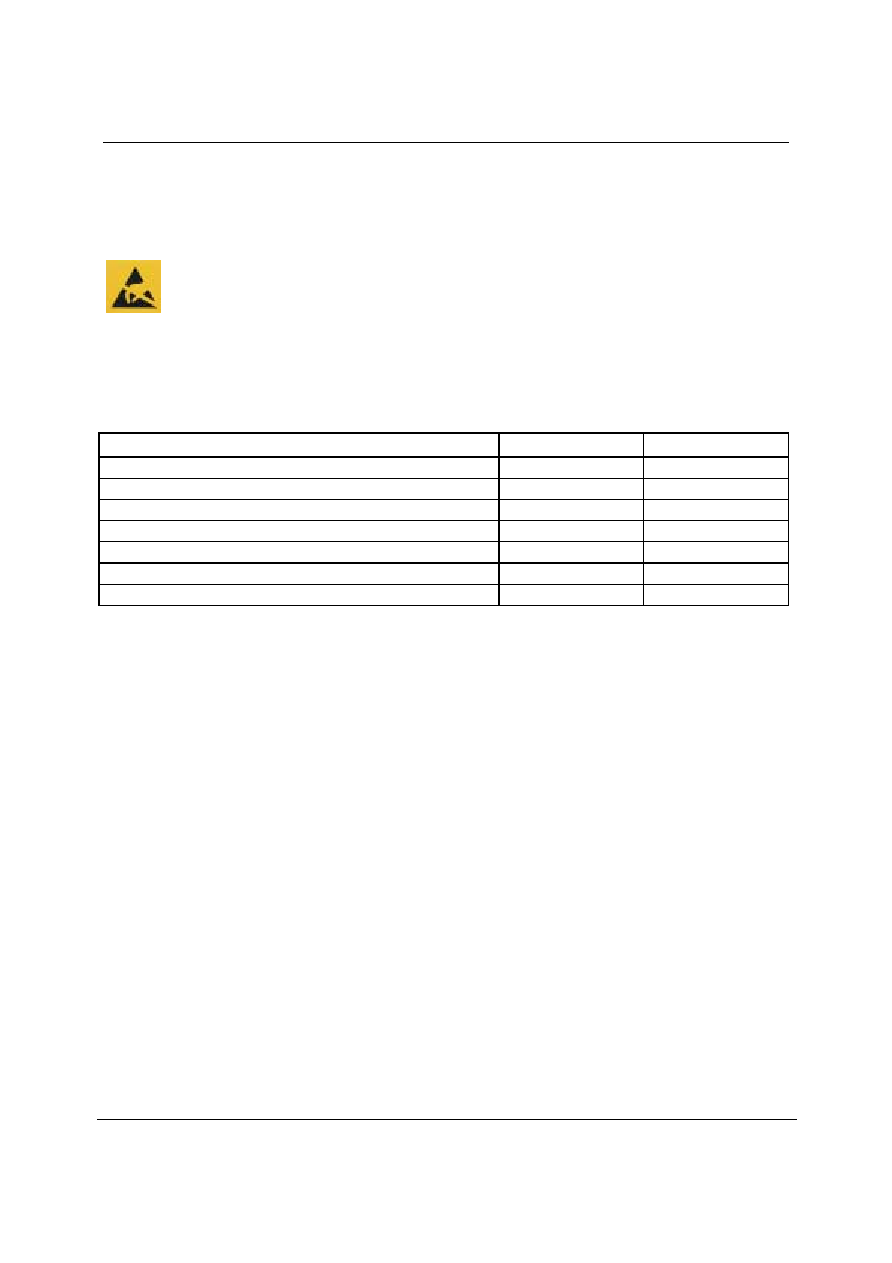
Product Preview
WM8569
w
PP Rev 1.1 December 2005
5
ABSOLUTE MAXIMUM RATINGS
Absolute Maximum Ratings are stress ratings only. Permanent damage to the device may be caused by continuously operating at
or beyond these limits. Device functional operating limits and guaranteed performance specifications are given under Electrical
Characteristics at the test conditions specified.
ESD Sensitive Device. This device is manufactured on a CMOS process. It is therefore generically susceptible
to damage from excessive static voltages. Proper ESD precautions must be taken during handling and storage
of this device.
Wolfson tests its package types according to IPC/JEDEC J-STD-020B for Moisture Sensitivity to determine acceptable storage
conditions prior to surface mount assembly. These levels are:
MSL1 = unlimited floor life at <30
∞C / 85% Relative Humidity. Not normally stored in moisture barrier bag.
MSL2 = out of bag storage for 1 year at <30
∞C / 60% Relative Humidity. Supplied in moisture barrier bag.
MSL3 = out of bag storage for 168 hours at <30
∞C / 60% Relative Humidity. Supplied in moisture barrier bag.
The Moisture Sensitivity Level for each package type is specified in Ordering Information.
CONDITION
MIN
MAX
Digital supply voltage
-0.3V
+5V
Analogue supply voltage
-0.3V
+7V
Voltage range digital inputs
1
DGND -0.3V
DVDD +0.3V
Voltage range analogue inputs
1
AGND -0.3V
AVDD +0.3V
Master Clock Frequency
37MHz
Operating temperature range, T
A
-25
∞C
+85
∞C
Storage temperature after soldering
-65
∞C
+150
∞C
Notes:
1.
Analogue and digital grounds must always be within 0.3V of each other.
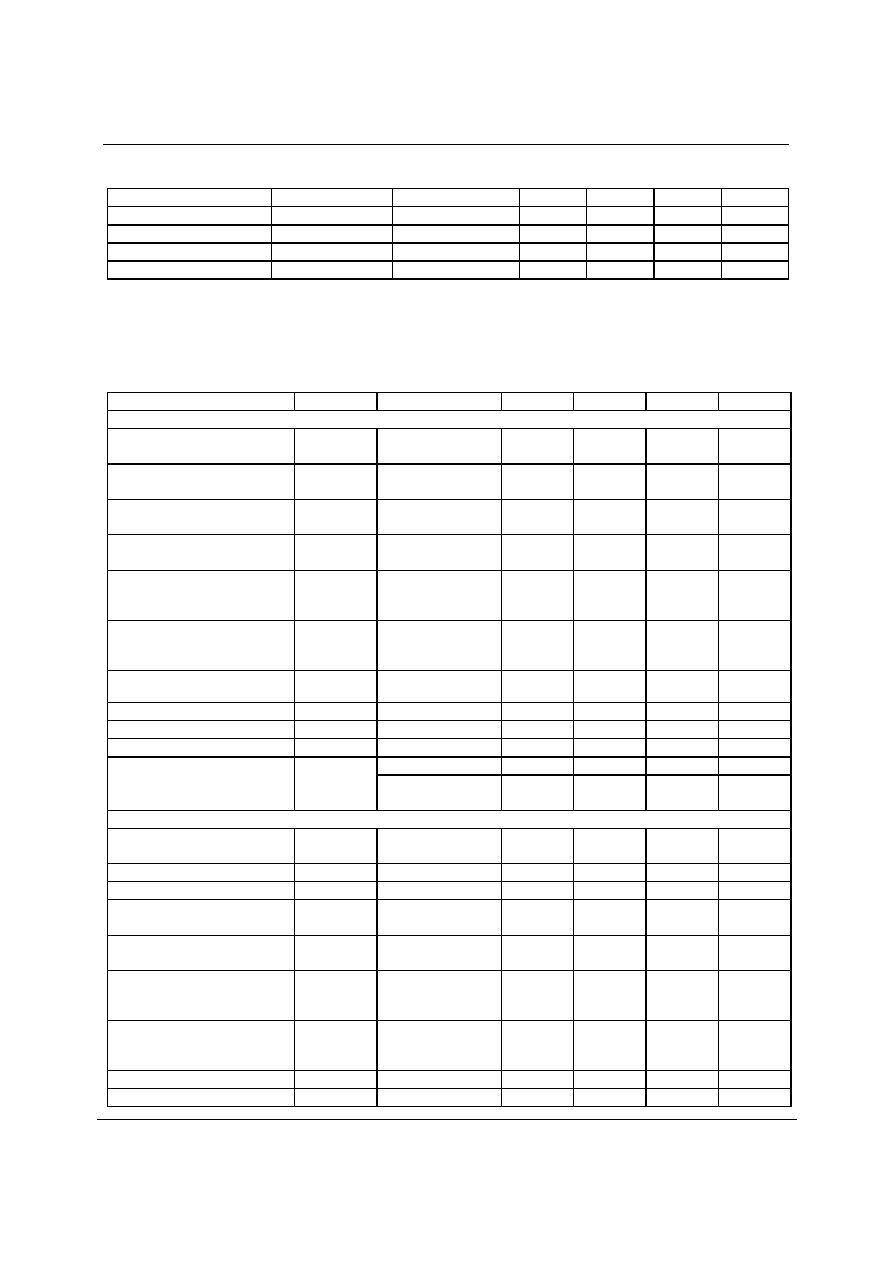
WM8569
Product Preview
w
PP Rev 1.1 December 2005
6
RECOMMENDED OPERATING CONDITIONS
PARAMETER
SYMBOL
TEST CONDITIONS
MIN
TYP
MAX
UNIT
Digital supply range
DVDD
2.7
3.6
V
Analogue supply range
AVDD, VREFP
2.7
5.5
V
Ground
AGND, VREFN, DGND
0
V
Difference DGND to AGND
-0.3
0
+0.3
V
Note: Digital supply DVDD must never be more than 0.3V greater than AVDD.
ELECTRICAL CHARACTERISTICS
Test Conditions
AVDD, VREFP = 5V, DVDD = 3.3V, AGND, VREFN = 0V, DGND = 0V, T
A
= +25
o
C, fs = 48kHz, MCLK = 256fs.
PARAMETER
SYMBOL
TEST CONDITIONS
MIN
TYP
MAX
UNIT
DAC Performance (Load
= 10k, 50pF)
0dBFs Full scale output voltage
1.0 x
VREFP/5
V
rms
SNR (Note 1,2,4)
A-weighted,
@ fs = 48kHz
103
dB
SNR (Note 1,2,4)
A-weighted
@ fs = 96kHz
102
dB
SNR (Note 1,2,4)
A-weighted
@ fs = 192kHz
101
dB
SNR (Note 1,2,4)
A-weighted
@ fs = 48kHz, AVDD =
3.3V
99
dB
SNR (Note 1,2,4)
A-weighted
@ fs = 96kHz, AVDD =
3.3V
99
dB
Dynamic Range (Note 2,4)
DNR
A-weighted, -60dB full
scale input
103
dB
Total Harmonic Distortion (THD)
1kHz, 0dB.Fs
-90
dB
Mute Attenuation
1kHz Input, 0dB gain
100
dB
DAC channel separation
100
dB
1kHz 100mV
p-p
50
dB
Power Supply Rejection Ratio
PSRR
20Hz to 20kHz
100mV
p-p
45
dB
ADC Performance
Input Signal Level (0dB)
2.0 x
REFADC/5
V
rms
Input resistance
20
k
Input capacitance
10
pF
SNR (Note 1,2,4)
A-weighted, 0dB gain
@ fs = 48kHz
100
dB
SNR (Note 1,2,4)
A-weighted, 0dB gain
@ fs = 96kHz
100
dB
SNR (Note 1,2,4)
A-weighted, 0dB gain
@ fs = 48kHz, AVDD =
3.3V
93
dB
SNR (Note 1,2,4)
A-weighted, 0dB gain
@ fs = 96kHz, AVDD
= 3.3V
93
dB
Total Harmonic Distortion (THD)
1kHz, -1dBFs
-82
dB
ADC Channel Separation
1kHz Input
90
dB

Product Preview
WM8569
w
PP Rev 1.1 December 2005
7
Test Conditions
AVDD, VREFP = 5V, DVDD = 3.3V, AGND, VREFN = 0V, DGND = 0V, T
A
= +25
o
C, fs = 48kHz, MCLK = 256fs.
PARAMETER
SYMBOL
TEST CONDITIONS
MIN
TYP
MAX
UNIT
Mute Attenuation
1kHz Input, 0dB gain
90
dB
1kHz 100mVpp
50
dB
Power Supply Rejection Ratio
PSRR
20Hz to 20kHz
100mVpp
45
dB
Digital Logic Levels (CMOS Levels)
Input LOW level
V
IL
0.3 x DVDD
V
Input HIGH level
V
IH
0.7 x DVDD
V
Input leakage current
±0.2
±1
µA
Input capacitance
5
pF
Output LOW
V
OL
I
OL
=1mA
0.1 x DVDD
V
Output HIGH
V
OH
I
OH
=
-1mA
0.9 x DVDD
V
Analogue Reference Levels
Reference voltage
V
VMID
VREFP/2 ≠
50mV
VREFP/2
VREFP/2 +
50mV
V
Potential divider resistance
R
VMID
VREFP to VMID and
VMID to VREFN
50
k
Supply Current
Analogue supply current
AVDD, VREFP = 5V
TBD
mA
Digital supply current
DVDD = 3.3V
TBD
mA
Notes:
1.
Ratio of output level with 1kHz full scale input, to the output level with all zeros into the digital input, measured `A'
weighted.
2.
All performance measurements done with 20kHz low pass filter, and where noted an A-weight filter. Failure to use
such a filter will result in higher THD+N and lower SNR and Dynamic Range readings than are found in the Electrical
Characteristics. The low pass filter removes out of band noise; although it is not audible it may affect dynamic
specification values.
3.
VMID decoupled with 10uF and 0.1uF capacitors (smaller values may result in reduced performance).
TERMINOLOGY
1.
Signal-to-noise ratio (dB) - SNR is a measure of the difference in level between the full scale output and the output
with no signal applied. (No Auto-zero or Automute function is employed in achieving these results).
2.
Dynamic range (dB) - DNR is a measure of the difference between the highest and lowest portions of a signal.
Normally a THD+N measurement at 60dB below full scale. The measured signal is then corrected by adding the 60dB
to it. (e.g. THD+N @ -60dB= -32dB, DR= 92dB).
3.
THD (dB) - THD is a ratio, of the rms values, of Distortion/Signal.
4.
Stop band attenuation (dB) - Is the degree to which the frequency spectrum is attenuated (outside audio band).
5.
Channel Separation (dB) - Also known as Cross-Talk. This is a measure of the amount one channel is isolated from
the other. Normally measured by sending a full scale signal down one channel and measuring the other.
6.
Pass-Band Ripple - Any variation of the frequency response in the pass-band region.

WM8569
Product Preview
w
PP Rev 1.1 December 2005
8
MASTER CLOCK TIMING
MCLK
t
MCLKL
t
MCLKH
t
MCLKY
Figure 1 ADC and DAC Master Clock Timing Requirements
Test Conditions
AVDD, VREFP = 5V, DVDD = 3.3V, AGND, VREFN = 0V, AGND, DGND = 0V, T
A
= +25
o
C, fs = 48kHz, DACMCLK and
ADCMCLK = 256fs unless otherwise stated.
PARAMETER
SYMBOL
TEST CONDITIONS
MIN
TYP
MAX
UNIT
System Clock Timing Information
MCLK System clock pulse width
high
t
MCLKH
11
ns
MCLK System clock pulse width
low
t
MCLKL
11
ns
MCLK System clock cycle time
t
MCLKY
28
ns
MCLK Duty cycle
40:60
60:40
Table 1 Master Clock Timing Requirements
DIGITAL AUDIO INTERFACE ≠ MASTER MODE
Figure 2 Audio Interface ≠ Master Mode

Product Preview
WM8569
w
PP Rev 1.1 December 2005
9
Figure 3 Digital Audio Data Timing ≠ Master Mode
Test Conditions
AVDD, VREFP = 5V, DVDD = 3.3V, AGND, VREFN, DGND = 0V, T
A
= +25
o
C, Master Mode, fs = 48kHz, MCLK = 256fs unless
otherwise stated.
PARAMETER
SYMBOL
TEST CONDITIONS
MIN
TYP
MAX
UNIT
Audio Data Input Timing Information
DACLRC/ADCLRC
propagation delay from
DACBCLK/ADCBCLK
falling edge
t
DL
0
10
ns
DOUT propagation delay
from ADCBCLK falling edge
t
DDA
0
10
ns
DIN setup time to
DACBCLK rising edge
t
DST
10
ns
DIN hold time from
DACBCLK rising edge
t
DHT
10
ns
Table 2 Digital Audio Data Timing ≠ Master Mode
DACBCLK/
ADCBCLK
(Output)
DOUT
DACLRC/
ADCLRC
(Output)
t
DL
DIN
t
DDA
t
DHT
t
DST

WM8569
Product Preview
w
PP Rev 1.1 December 2005
10
DIGITAL AUDIO INTERFACE ≠ SLAVE MODE
Figure 4 Audio Interface ≠ Slave Mode
Figure 5 Digital Audio Data Timing ≠ Slave Mode

Product Preview
WM8569
w
PP Rev 1.1 December 2005
11
Test Conditions
AVDD = 5V, DVDD = 3.3V, AGND = 0V, DGND = 0V, T
A
= +25
o
C, Slave Mode, fs = 48kHz, DACMCLK and ADCMCLK = 256fs
unless otherwise stated.
PARAMETER
SYMBOL
TEST CONDITIONS
MIN
TYP
MAX
UNIT
Audio Data Input Timing Information
ADCBCLK/DACBCLK cycle
time
t
BCY
50
ns
ADCBCLK/DACBCLK pulse
width high
t
BCH
20
ns
ADCBCLK/DACBCLK pulse
width low
t
BCL
20
ns
ADCLRC/DACLRC set-up
time to
ADCBCLK/DACBCLK rising
edge
t
LRSU
10
ns
ADCLRC/DACLRC hold
time from
ADCBCLK/DACBCLK rising
edge
t
LRH
10
ns
DIN set-up time to
DACBCLK rising edge
t
DS
10
ns
DIN hold time from
DACBCLK rising edge
t
DH
10
ns
DOUT propagation delay
from ADCBCLK falling edge
t
DD
0
10
ns
Table 3 Digital Audio Data Timing ≠ Slave Mode

WM8569
Product Preview
w
PP Rev 1.1 December 2005
12
MPU INTERFACE TIMING
Figure 6 SPI Compatible Control Interface Input Timing
Test Conditions
AVDD = 5V, DVDD = 3.3V, AGND, DGND = 0V, T
A
= +25
o
C, fs = 48kHz, DACMCLK and ADCMCLK = 256fs unless otherwise
stated
PARAMETER
SYMBOL
MIN
TYP
MAX
UNIT
SCLK/IWL rising edge to CSB/IDF rising edge
t
SCS
60
ns
SCLK/IWL pulse cycle time
t
SCY
80
ns
SCLK/IWL pulse width low
t
SCL
30
ns
SCLK/IWL pulse width high
t
SCH
30
ns
SDIN/DM to SCLK/IWL set-up time
t
DSU
20
ns
SCLK/IWL to SDIN/DM hold time
t
DHO
20
ns
CSB/IDF pulse width low
t
CSL
20
ns
CSB/IDF pulse width high
t
CSH
20
ns
CSB/IDF rising to SCLK/IWL rising
t
CSS
20
ns
Table 4 3-Wire SPI Compatible Control Interface Input Timing Information

Product Preview
WM8569
w
PP Rev 1.1 December 2005
13
DEVICE DESCRIPTION
INTRODUCTION
WM8569 is a complete 2-channel audio codec, including digital interpolation and decimation filters,
multi-bit sigma delta stereo ADC, and switched capacitor multi-bit sigma delta DAC with volume
control and output smoothing filter.
The device is implemented as a separate stereo DAC and a stereo ADC in a single package and
controlled by a single 3-wire software or hardware interface.
The DAC has its own data input DIN, DAC word clock DACLRC, DAC bit clock DACBCLK and DAC
master clock DACMCLK while the stereo ADC has its own data output DOUT, word clock ADCLRC,
bit clock ADCBCLK and ADC master clock ADCMCLK. This allows the ADC and DAC to operate
independently.
The Audio Interface may be configured to operate in either master or slave mode. In Slave mode
DACLRC/ADCLRC and DACBCLK/ADCBCLK are all inputs. In Master mode DACLRC/ADCLRC and
DACBCLK/ADCBCLK are all outputs.
The DAC has its own digital volume control that is adjustable in 0.5dB steps. A zero cross detect
circuit is provided. The digital volume control detects a transition through the zero point before
updating the volume. This minimises audible clicks and `zipper' noise as the gain values change.
Control of internal functionality of the device is by 3-wire serial or pin programmable control interface.
Operation using master clocks of 128fs, 192fs, 256fs, 384fs, 512fs or 768fs is provided for the DAC,
for operation of both the ADC and DAC master clocks of 256fs, 384fs, 512fs and 768fs is provided.
In Slave mode, selection between clock rates is automatically controlled. In master mode, the
sample rate is set by control bits RATE. Audio sample rates (fs) from less than 8kHz up to 192kHz
are allowed for the DAC and from less than 32kHz up to 96kHz for the ADC, provided the appropriate
master clock is input.
The audio data interface supports right, left and I
2
S interface formats along with a highly flexible DSP
serial port interface.
AUDIO DATA SAMPLING RATES
In a typical digital audio system there is only one central clock source producing a reference clock to
which all audio data processing is synchronised. This clock is often referred to as the audio system's
Master Clock. The external master system clock can be applied directly through the ADC and DAC
MCLK input pin(s) with no software configuration necessary. In a system where there are a number
of possible sources for the reference clock it is recommended that the clock source with the lowest
jitter be used to optimise the performance of the ADC and DAC.
The DAC master clock for WM8569 supports audio sampling rates from 128fs to 768fs, where fs is
the audio sampling frequency (DACLRC) typically 32kHz, 44.1kHz, 48kHz, 96kHz or 192kHz. The
ADC master clock for WM8569 supports audio sampling rates from 256fs to 768fs, where fs is the
audio sampling frequency (ADCLRC) typically 32kHz, 44.1kHz, 48kHz or 96kHz. The master clock is
used to operate the digital filters and the noise shaping circuits.
In Slave mode the WM8569 has a master clock detection circuit that automatically determines the
relationship between the system clock frequency and the sampling rate (to within +/- 32 master
clocks). If there is a greater than 32 clocks error the interface defaults to 768fs mode. The master
clocks must be synchronised with LRC, although the WM8569 is tolerant of phase variations or jitter
on this clock. Table 5 shows the typical master clock frequency inputs for the WM8569.
The signal processing for the WM8569 typically operates at an oversampling rate of 128fs for both
ADC and DAC. The exception to this for the DAC is for operation with a 128/192fs system clock, e.g.
for 192kHz operation, when the oversampling rate is 64fs. For ADC operation at 96kHz it is
recommended that the user set the ADCOSR bit. This changes the ADC signal processing
oversample rate to 64fs.
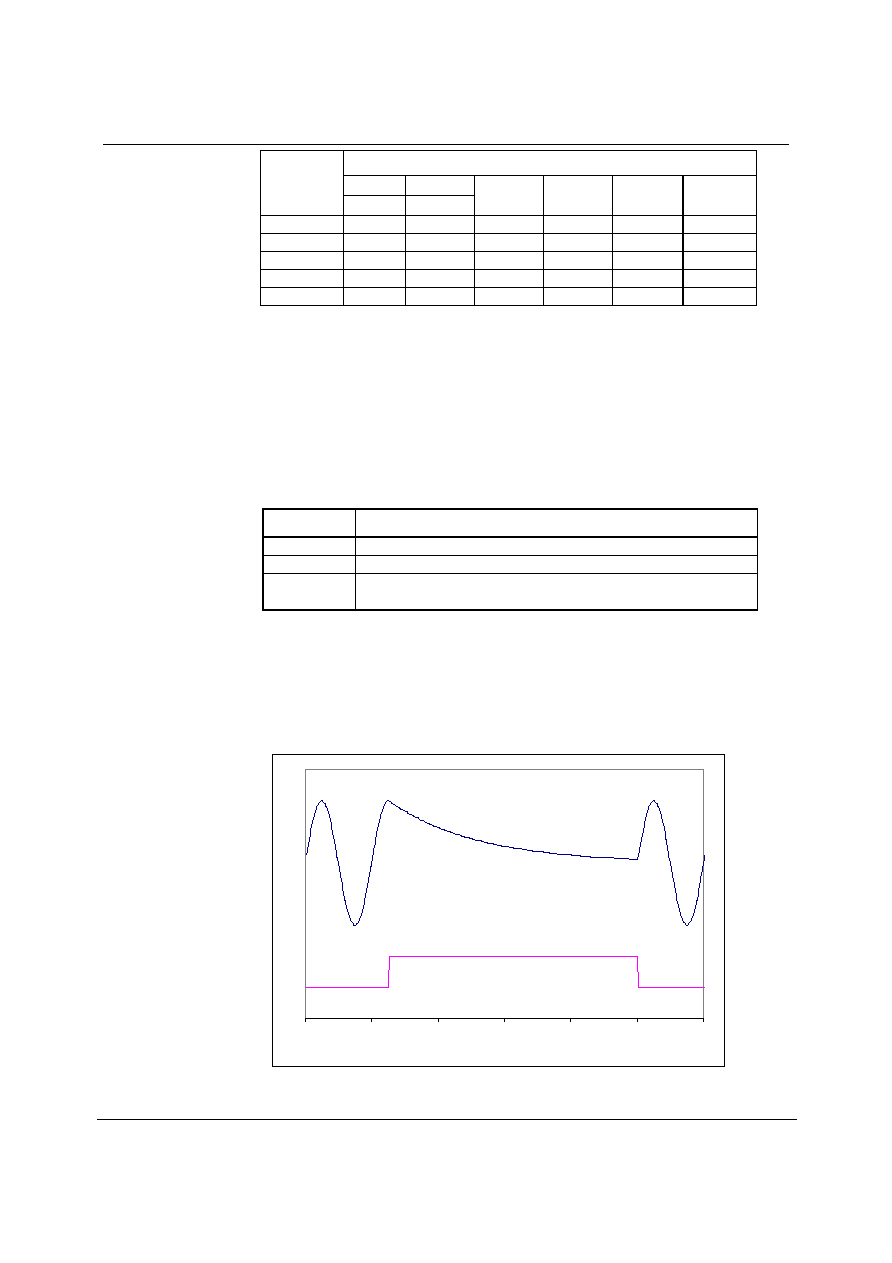
WM8569
Product Preview
w
PP Rev 1.1 December 2005
14
System Clock Frequency (MHz)
128fs
192fs
SAMPLING
RATE
(DACLRC/
ADCLRC)
DAC only
DAC only
256fs
384fs
512fs
768fs
32kHz
4.096
6.144
8.192
12.288
16.384
24.576
44.1kHz
5.6448
8.467
11.2896
16.9340
22.5792
33.8688
48kHz
6.144
9.216
12.288
18.432
24.576
36.864
96kHz
12.288
18.432
24.576
36.864
Unavailable Unavailable
192kHz
24.576
36.864
Unavailable Unavailable Unavailable Unavailable
Table 5 System Clock Frequencies Versus Sampling Rate
HARDWARE CONTROL MODES
When the MODE pin is held high, the following hardware modes of operation are available.
Note: When in hardware mode the ADC and DAC will only run in slave mode.
MUTE AND AUTOMUTE OPERATION
In both hardware and software modes, MUTE controls the selection of MUTE directly, and can be
used to enable and disable the automute function. This pin becomes an output when left floating and
indicates infinite ZERO detect (IZD) has been detected.
DESCRIPTION
0
Normal Operation
1
Mute DAC channels
Floating
Enable IZD, MUTE becomes an output to indicate when IZD occurs.
L=IZD detected, H=IZD not detected.
Table 6 Mute and Automute Control
Figure 7 shows the application and release of MUTE whilst a full amplitude sinusoid is being played
at 48kHz sampling rate. When MUTE (lower trace) is asserted, the output (upper trace) begins to
decay exponentially from the DC level of the last input sample. The output will decay towards V
MID
with a time constant of approximately 64 input samples. If MUTE is applied to all channels for 1024
or more input samples the outputs will be connected directly to V
MID
if IZD is set. When MUTE is de-
asserted, the output will restart immediately from the current input sample.
Figure 7 Application and Release of Soft Mute
-2.5
-2
-1.5
-1
-0.5
0
0.5
1
1.5
0
0.001
0.002
0.003
0.004
0.005
0.006
Time(s)

Product Preview
WM8569
w
PP Rev 1.1 December 2005
15
The MUTE pin is an input to select mute or not mute. MUTE is active high; taking the pin high
causes the filters to soft mute, ramping down the audio signal over a few milliseconds. Taking MUTE
low again allows data into the filter.
The automute function detects a series of ZERO value audio samples of 1024 samples long being
applied to both channels. After such an event, a latch is set whose output (AUTOMUTED) is wire
OR'd through a 10k resistor to the MUTE pin. Thus if the MUTE pin is not being driven, the
automute function will assert mute.
If MUTE is tied low, AUTOMUTED is overridden and will not mute unless the IZD register bit is set. If
MUTE is driven from a bi-directional source, then both MUTE and automute functions are available. If
MUTE is not driven, AUTOMUTED appears as a weak output (10k source impedance) and can be
used to drive external mute circuits. AUTOMUTED will be removed as soon as any channel receives
a non-ZERO input.
A diagram showing how the various Mute modes interact is shown below.
IZD (Register Bit)
AUTOMUTED
(Internal Signal)
10k
MUTE (Register Bit)
SOFTMUTE
(Internal
Signal)
MUTE
PIN
Figure 8 Control of MUTE Modes
INPUT FORMAT SELECTION
In hardware mode, CSB/IDF and SCLK/IWL become input controls for selection of input data format
type and input data word length for both the ADC and DAC.
CSB/IDF
SCLK/IWL
INPUT DATA MODE
0
0
24-bit right justified
0
1
20-bit right justified
1
0
16-bit I
2
S
1
1
24-bit I
2
S
Table 7 Input Format Selection
Note:
In 24 bit I
2
S mode, any width of 24 bits or less is supported provided that the left/right clocks
(ADCLRC and DACLRC) are high for a minimum of 24 bit clocks (ADCBCLK and DACBCLK) and
low for a minimum of 24 bit clocks.
DE-EMPHASIS CONTROL
In hardware mode, the SDIN/DM pin becomes an input control for selection of de-emphasis filtering
to be applied.
SDIN/DM
DE-EMPHASIS
0
Off
1
On
Table 8 De-emphasis Control
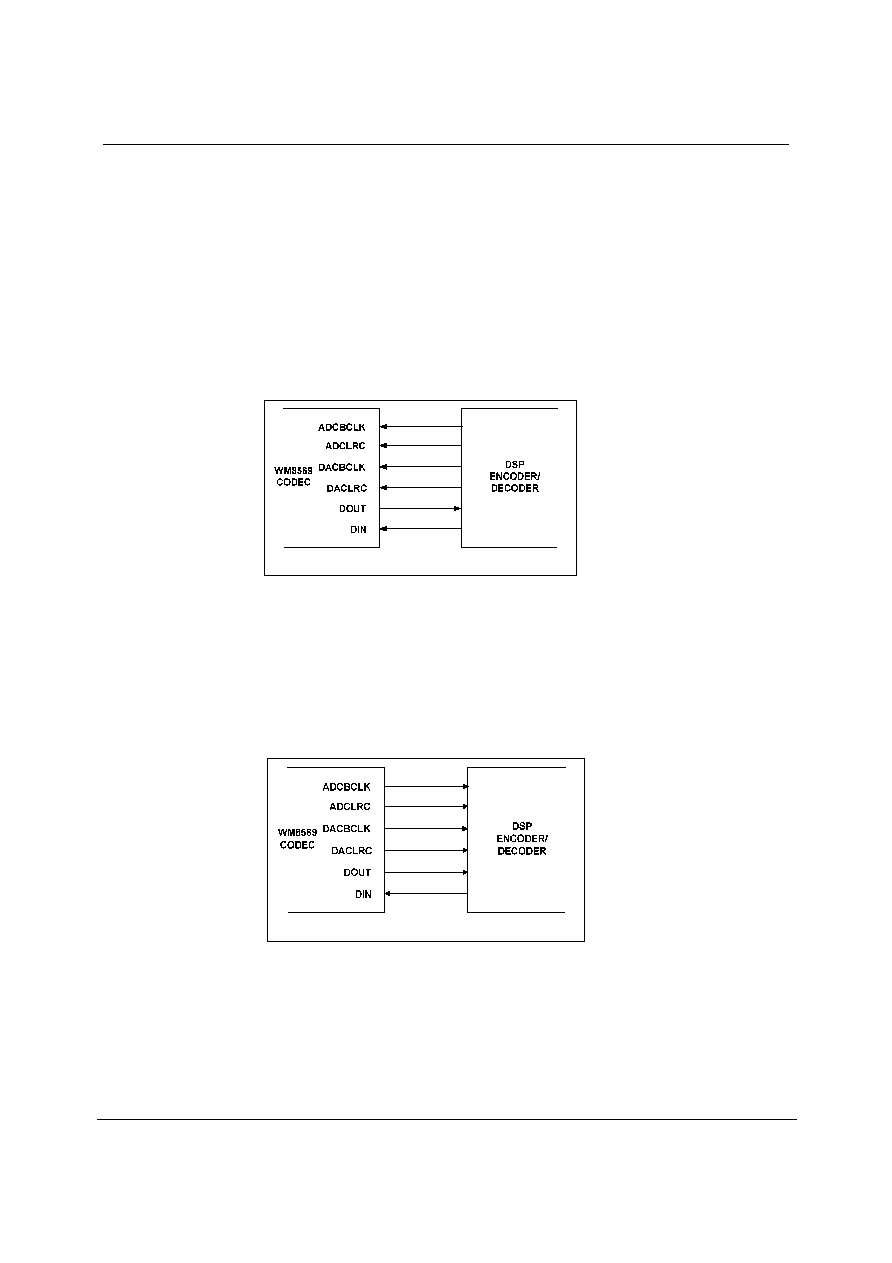
WM8569
Product Preview
w
PP Rev 1.1 December 2005
16
DIGITAL AUDIO INTERFACE
MASTER AND SLAVE MODES
The audio interface operates in either Slave or Master mode, selectable using the DACMS and
ADCMS control bits. In both Master and Slave modes DIN is always an input to the WM8569 and
DOUT is always an output. The default is Slave mode.
In Slave mode, DACLRC, ADCLRC, DACBCLK and ADCBCLK are inputs to the WM8569 (Figure 9).
DIN and DACLRC are sampled by the WM8569 on the rising edge of DACBCLK. ADC data is output
on DOUT and changes on the falling edge of ADCBCLK.
By setting the control bit DACBCP the polarity of DACBCLK may be reversed so that DIN is sampled
on the falling edge of DACBCLK. By setting the control bit ADCBCP, the polarity of ADCBCLK may
be reversed so that DOUT changes on the rising edge of ADCBCLK.
Figure 9 Slave Mode
In Master mode, DACLRC, ADCLRC, DACBCLK and ADCBCLK are outputs from the WM8569
(Figure 10). DACLRC, ADCLRC, DACBCLK and ADCBCLK are generated by the WM8569. DIN is
sampled by the WM8569 on the rising edge of DACBCLK so the controller must output DAC data
that changes on the falling edge of DACBCLK. ADC data is output on DOUT and changes on the
falling edge of ADCBCLK.
By setting the control bit DACBCP the polarity of DACBCLK may be reversed so that DIN is sampled
on the falling edge of DACBCLK. By setting the control bit ADCBCP, the polarity of ADCBCLK may
be reversed so that DOUT changes on the rising edge of ADCBCLK.
Figure 10 Master Mode
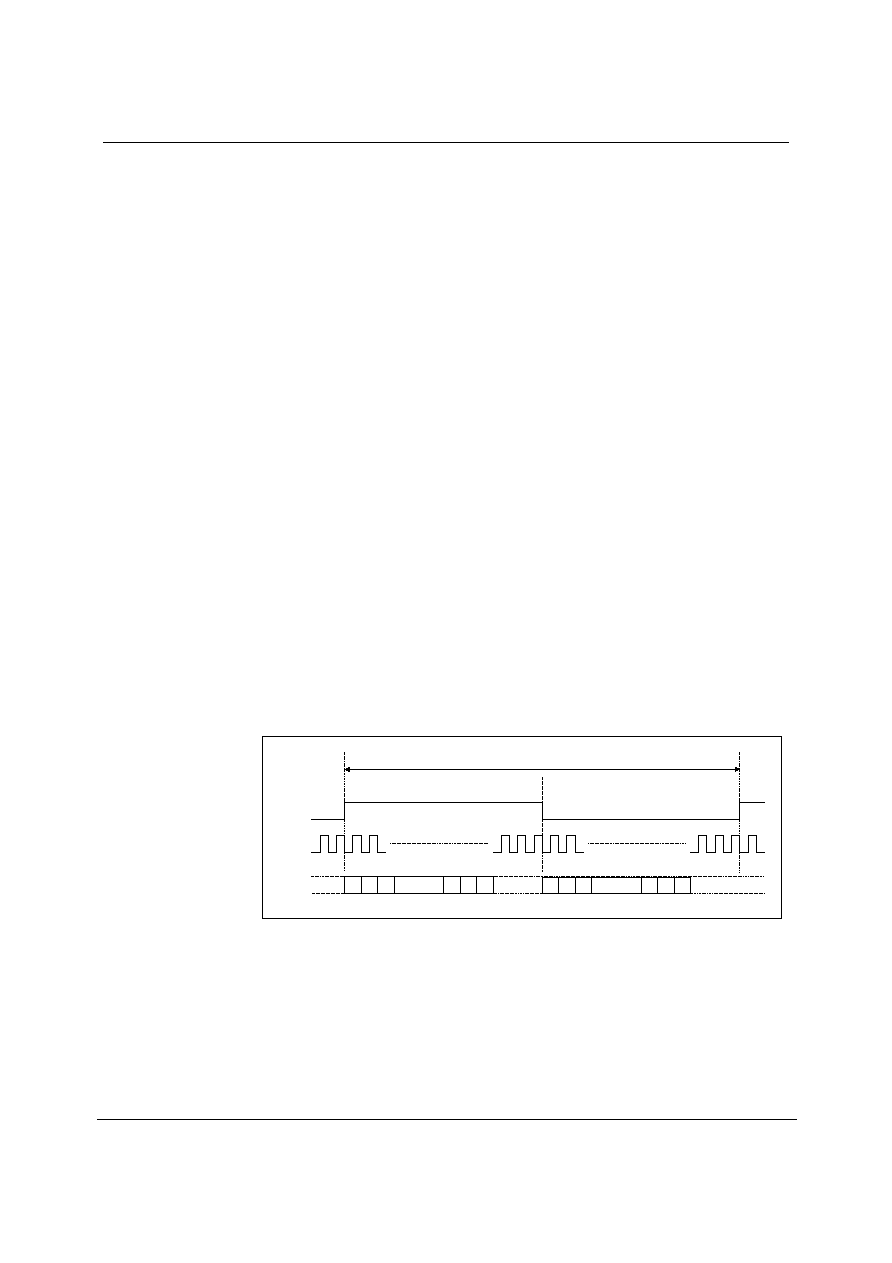
Product Preview
WM8569
w
PP Rev 1.1 December 2005
17
AUDIO INTERFACE FORMATS
Audio data is applied to the internal DAC filters or output from the ADC filters, via the Digital Audio
Interface. 5 popular interface formats are supported:
∑
Left Justified mode
∑
Right Justified mode
∑
I
2
S mode
∑
DSP Mode A
∑
DSP Mode B
All 5 formats send the MSB first and support word lengths of 16, 20, 24 and 32 bits, with the
exception of 32 bit right justified mode, which is not supported.
In left justified, right justified and I
2
S modes, the digital audio interface receives DAC data on the DIN
input and outputs ADC data on DOUT. Audio Data for each stereo channel is time multiplexed with
DACLRC/ADCLRC indicating whether the left or right channel is present. DACLRC/ADCLRC is also
used as a timing reference to indicate the beginning or end of the data words.
In left justified, right justified and I
2
S modes, the minimum number of BCLKs per LRC period is 2
times the selected word length. LRC must be high for a minimum of word length BCLKs and low for a
minimum of word length BCLKs. Any mark to space ratio on LRC is acceptable provided the above
requirements are met.
In DSP mode A or B, the DAC channels are time multiplexed onto DIN. LRC is used as a frame sync
signal to identify the MSB of the first word. The minimum number of DACBCLKs per DACLRC period
is 6 times the selected word length. Any mark to space ratio is acceptable on DACLRC provided the
rising edge is correctly positioned. The ADC data may also be output in DSP mode A or B, with
ADCLRC used as a frame sync to identify the MSB of the first word. The minimum number of
ADCBCLKs per ADCLRC period is 2 times the selected word length if only the ADC is being
operated.
LEFT JUSTIFIED MODE
In left justified mode, the MSB of DIN is sampled by the WM8569 on the first rising edge of
DACBCLK following a DACLRC transition. The MSB of the ADC data is output on DOUT and
changes on the same falling edge of ADCBCLK as ADCLRC and may be sampled on the rising edge
of BCLK. LRC is high during the left samples and low during the right samples (Figure 11).
LEFT CHANNEL
RIGHT CHANNEL
DACLRC/
ADCLRC
DACBCLK/
ADCBCLK
DIN1/2/3/
DOUT
1/fs
n
3
2
1
n-2 n-1
LSB
MSB
n
3
2
1
n-2 n-1
LSB
MSB
Figure 11 Left Justified Mode Timing Diagram
RIGHT JUSTIFIED MODE
In right justified mode, the LSB of DIN is sampled by the WM8569 on the rising edge of DACBCLK
preceding a DACLRC transition. The LSB of the ADC data is output on DOUT and changes on the
falling edge of ADCBCLK preceding a ADCLRC transition and may be sampled on the rising edge of
ADCBCLK. LRC are high during the left samples and low during the right samples (Figure 12).

WM8569
Product Preview
w
PP Rev 1.1 December 2005
18
LEFT CHANNEL
RIGHT CHANNEL
DACLRC/
ADCLRC
DACBCLK/
ADCBCLK
DIN1/2/3/
DOUT
1/fs
n
3
2
1
n-2 n-1
LSB
MSB
n
3
2
1
n-2 n-1
LSB
MSB
Figure 12 Right Justified Mode Timing Diagram
I
2
S MODE
In I
2
S mode, the MSB of DIN is sampled by the WM8569 on the second rising edge of DACBCLK
following a DACLRC transition. The MSB of the ADC data is output on DOUT and changes on the
first falling edge of ADCBCLK following an ADCLRC transition and may be sampled on the rising
edge of ADCBCLK. LRC are low during the left samples and high during the right samples.
LEFT CHANNEL
RIGHT CHANNEL
DACLRC/
ADCLRC
DACBCLK/
ADCBCLK
DIN1/2/3/
DOUT
1/fs
n
3
2
1
n-2 n-1
LSB
MSB
n
3
2
1
n-2 n-1
LSB
MSB
1 BCLK
1 BCLK
Figure 13 I
2
S Mode Timing Diagram
DSP MODE A
In DSP mode A, the MSB of DAC left channel data is sampled by the WM8569 on the second rising
edge on DACBCLK following a DACLRC rising edge. DAC right channel follows DAC left channel
(Figure 14).
Figure 14 DSP Mode A Timing Diagram ≠ DAC Data Input
The MSB of the left channel ADC data is output on DOUT and changes on the first falling edge of
ADCBCLK following a low to high ADCLRC transition and may be sampled on the rising edge of
ADCBCLK. The right channel ADC data is contiguous with the left channel data (Figure 15)

Product Preview
WM8569
w
PP Rev 1.1 December 2005
19
ADCLRC
ADCBCLK
DOUT
Input Word Length (IWL)
1/fs
LEFT CHANNEL
n
2
1
n-1
LSB
MSB
n
2
1
n-1
RIGHT CHANNEL
NO VALID DATA
1 BCLK
1 BCLK
Figure 15 DSP Mode A Timing Diagram ≠ ADC Data Output
DSP MODE B
In DSP mode B, the MSB of DAC left channel data is sampled by the WM8569 on the first
DACBCLK rising edge following a DACLRC rising edge. (Figure 16).
Figure 16 DSP Mode B Timing Diagram ≠ DAC Data Input
The MSB of the left channel ADC data is output on DOUT and changes on the same falling edge of
ADCBCLK as the low to high ADCLRC transition and may be sampled on the rising edge of
ADCBCLK. The right channel ADC data is contiguous with the left channel data (Figure 17).
ADCLRC
BCK
DOUT
Input Word Length (IWL)
1/fs
LEFT CHANNEL
n
2
1
n-1
LSB
MSB
n
2
1
n-1
RIGHT CHANNEL
NO VALID DATA
1
Figure 17 DSP Mode B Timing Diagram ≠ ADC Data Output

WM8569
Product Preview
w
PP Rev 1.1 December 2005
20
POWERDOWN MODES
The WM8569 has powerdown control bits allowing specific parts of the WM8569 to be powered off
when not being used. Control bit ADCPD powers off the ADC. The three stereo DACs each have a
separate powerdown control bit, DACPD[2:0] allowing individual stereo DACs to be powered off when
not in use. Setting ADCPD and DACPD[2:0] will powerdown everything except the references VMID
and REFADC. These may be powered down by setting PDWN. Setting PDWN will override all other
powerdown control bits. It is recommended that the ADC and DACs are powered down before setting
PDWN.
ZERO DETECT
The WM8569 has a zero detect circuit for each DAC channel that detects when 1024 consecutive
zero samples have been input. The MUTE pin output may be programmed to output the zero detect
signal which may then be used to control external muting circuits. A `1' on MUTE indicates a zero
detect. The zero detect may also be used to automatically enable DAC mute by setting IZD.
SOFTWARE CONTROL INTERFACE OPERATION
The WM8569 is controlled using a 3-wire serial interface in software mode or pin
programmable in hardware mode.
The control mode is selected by the state of the MODE pin.
3-WIRE (SPI COMPATIBLE) SERIAL CONTROL MODE
SDIN/DM is used for the program data, SCLK/IWL is used to clock in the program data and CSB/IDF
is used to latch the program data. SDIN/DM is sampled on the rising edge of SCLK/IWL. The 3-wire
interface protocol is shown in Figure 18.
Figure 18 3-Wire SPI Compatible Interface
Notes:
1.
B[15:9] are Control Address Bits
2.
B[8:0] are Control Data Bits
3.
CSB/IDF is edge sensitive ≠ the data is latched on the rising edge of CSB/IDF.

Product Preview
WM8569
w
PP Rev 1.1 December 2005
21
REGISTER MAP
The complete register map is shown below. The detailed description can be found in the relevant text of the device description. The
WM8569 can be configured using the Control Interface. All unused bits should be set to `0'.
REGISTER
B15
B14
B13
B12
B11
B10
B9
B8
B7
B6
B5
B4
B3
B2
B1
B0
DEFAULT
R0(00h)
0
0
0
0
0
0
0
UPDATE
LDA[7:0]
011111111
R1(01h)
0
0
0
0
0
0
1
UPDATE
RDA[7:0]
011111111
R2(02h)
0
0
0
0
0
1
0
PL[8:5]
IZD
ATC
0
0
0
100100000
R3(03h)
0
0
0
0
0
1
1
0
0
PHASE
DACIWL[5:4]
DACBCP
DACLRP
DACFMT[1:0]
000000000
R8(08h)
0
0
0
1
0
0
0
UPDATE
MASTDA[7:0]
011111111
R9(09h)
0
0
0
1
0
0
1
0
0
DEEMP
0
0
DMUTE
0
0
ZCD
000000000
R10(0Ah)
0
0
0
1
0
1
0
DACRATE[8:6]
DACMS PWRDNALL
0
0
DACPD
ADCPD
010000000
R11(0Bh)
0
0
0
1
0
1
1
ADC
OSR
ADCRATE[7:5]
ADCMS
ADCIWL[3:2]
ADCFMT[1:0]
001000000
R12(0Ch)
0
0
0
1
1
0
0
0
0
MPD
ADCBCP ADCLRP ADCHP
AMUTE
ALL
AMUTEL AMUTER
000000000
R31(1Fh)
0
0
1
1
1
1
1
RESET
000000000

WM8569
Product Preview
w
PP Rev 1.1 December 2005
22
CONTROL INTERFACE REGISTERS
ATTENUATOR CONTROL MODE
Setting the ATC register bit causes the left channel attenuation settings to be applied to both the left
and right channel of the DAC from the next audio input sample. No update to the attenuation
registers is required for ATC to take effect.
REGISTER ADDRESS
BIT
LABEL
DEFAULT
DESCRIPTION
0000010
DAC Channel Control
3
ATC
0
Attenuator Control Mode:
0: Right channel use right
attenuations
1: Right channel use left
attenuations
INFINITE ZERO DETECT ENABLE
Setting the IZD register bit will enable the internal infinite zero detect function:
REGISTER ADDRESS
BIT
LABEL
DEFAULT
DESCRIPTION
0000010
DAC Channel Control
4
IZD
0
Infinite Zero Mute Enable
0 : Disable inifinite zero mute
1: Enable infinite zero mute
With IZD enabled, applying 1024 consecutive zero input samples each stereo channel will cause that
stereo channel outputs to be muted to V
MID
. Mute will be removed as soon as that stereo channel
receives a non-zero input.
DAC OUTPUT CONTROL
The DAC output control word determines how the left and right input to the audio Interface are
applied to the left and right DAC:
REGISTER ADDRESS
BIT
LABEL
DEFAULT
DESCRIPTION
PL[3:0]
Left
Output
Right
Output
0000
Mute
Mute
0001
Left
Mute
0010
Right
Mute
0011
(L+R)/2
Mute
0100
Mute
Left
0101
Left
Left
0110
Right
Left
0111
(L+R)/2
Left
1000
Mute
Right
1001
Left
Right
1010
Right
Right
1011
(L+R)/2
Right
1100
Mute
(L+R)/2
1101
Left
(L+R)/2
1110
Right
(L+R)/2
0000010
DAC Control
8:5
PL[3:0]
1001
1111
(L+R)/2
(L+R)/2

Product Preview
WM8569
w
PP Rev 1.1 December 2005
23
DAC DIGITAL AUDIO INTERFACE CONTROL REGISTER
Interface format is selected via the DACFMT[1:0] register bits:
REGISTER ADDRESS
BIT
LABEL
DEFAULT
DESCRIPTION
0000011
Interface Control
1:0
DACFMT
[1:0]
00
Interface Format Select:
00 : Right justified mode
01: Left justified mode
10: I
2
S mode
11: DSP mode A orB
In left justified, right justified or I
2
S modes, the DACLRP register bit controls the polarity of DACLRC.
If this bit is set high, the expected polarity of DACLRC will be the opposite of that shown Figure 11,
Figure 12 and Figure 13. Note that if this feature is used as a means of swapping the left and right
channels, a 1 sample phase difference will be introduced. In DSP modes, the DACLRP register bit is
used to select between modes A and B.
REGISTER ADDRESS
BIT
LABEL
DEFAULT
DESCRIPTION
In left/right/I
2
S Modes:
DACLRC Polarity (normal)
0 : Normal DACLRC polarity
1: Inverted DACLRC polarity
0000011
Interface Control
2
DACLRP
0
In DSP Mode:
0 : Mode A
1: Mode B
By default, DACLRC and DIN are sampled on the rising edge of DACBCLK and should ideally
change on the falling edge. Data sources that change DACLRC and DIN on the rising edge of
DACBCLK can be supported by setting the DACBCP register bit. Setting DACBCP to 1 inverts the
polarity of DACBCLK to the inverse of that shown in Figure 11 to Figure 17.
REGISTER ADDRESS
BIT
LABEL
DEFAULT
DESCRIPTION
0000011
Interface Control
3
DACBCP
0
DACBCLK Polarity (DSP Modes):
0: Normal BCLK polarity
1: Inverted BCLK polarity
The DACIWL[1:0] bits are used to control the input word length.
REGISTER ADDRESS
BIT
LABEL
DEFAULT
DESCRIPTION
0000011
Interface Control
5:4
DACIWL
[1:0]
00
Input Word Length:
00 : 16 bit data
01: 20 bit data
10: 24 bit data
11: 32 bit data
Note: 32-bit right justified mode is not supported.
In all modes, the data is signed 2's complement. The digital filters always input 24-bit data. If the
DAC is programmed to receive 16 or 20 bit data, the WM8569 pads the unused LSBs with zeros. If
the DAC is programmed into 32 bit mode, the 8 LSBs are ignored.
Note: In 24 bit I
2
S mode, any width of 24 bits or less is supported provided that LRC is high for a
minimum of 24 BCLKs and low for a minimum of 24 BCLKs.
A number of options are available to control how data from the Digital Audio Interface is applied to
the DAC channels.

WM8569
Product Preview
w
PP Rev 1.1 December 2005
24
DAC OUTPUT PHASE
The DAC Phase control word determines whether the output of the DAC is non-inverted or inverted
REGISTER ADDRESS
BIT
LABEL
DEFAULT
DESCRIPTION
0000011
DAC Phase
6
PHASE
0
0 = non-inverted
1 = inverted
DIGITAL ZERO CROSS-DETECT
The Digital volume control also incorporates a zero cross detect circuit which detects a transition
through the zero point before updating the digital volume control with the new volume. This is
enabled by control bit ZCD.
REGISTER ADDRESS
BIT
LABEL
DEFAULT
DESCRIPTION
0001001
DAC Control
0
ZCD
0
DAC Digital Volume Zero Cross
Disable:
0: Zero cross detect enabled
1: Zero cross detect disabled
DAC MUTE MODES
The WM8569 has a mute for the DAC channels. Setting MUTE will apply a `soft' mute to the input of
the digital filters.
REGISTER ADDRESS
BIT
LABEL
DEFAULT
DESCRIPTION
0001001
DAC Mute
3
DMUTE
0
DAC Soft Mute Select
0 = Not mute
1 = Mute
Refer to Figure 7 for the plot of application and release of soft mute.
Note that all other means of muting the DAC channels: setting the PL[3:0] bits to 0, setting the
PDWN bit or setting attenuation to 0 will cause much more abrupt muting of the output.

Product Preview
WM8569
w
PP Rev 1.1 December 2005
25
ADC MUTE MODES
Each ADC channel also has a mute control bit, which mutes the inputs to the ADC.
REGISTER ADDRESS
BIT
LABEL
DEFAULT
DESCRIPTION
0
AMUTER
0
ADC Mute Select:
0 : Normal operation
1: mute ADC right
1
AMUTEL
0
ADC Mute Select:
0 : Normal operation
1: mute ADC left
0001100
ADC Mute
2
AMUTEALL
0
ADC Mute Select:
0 : Normal operation
1: mute both ADC channels
DE-EMPHASIS MODE
Each stereo DAC channel has an individual de-emphasis control bit:
REGISTER ADDRESS
BIT
LABEL
DEFAULT
DESCRIPTION
0001001
DAC De-Emphahsis
Control
6
DEEMPH
0
De-emphasis Channel Selection
Select:
0 = Not de-emphasis
1 = De-emphasis
POWERDOWN MODE AND ADC/DAC DISABLE
The ADC and DAC may be powered down individually by setting the ADCPD and DACPD disable
bits. Setting ADCPD will disable the ADC and select a low power mode. The ADC digital filters will be
reset and will reinitialise when ADCPD is unset. Setting DACPD will disable the DAC and select a low
power mode.
REGISTER ADDRESS
BIT
LABEL
DEFAULT
DESCRIPTION
0
ADCPD
0
ADC Disable:
0: Active
1: Disable
0001010
Powerdown Control
1
DACPD
0
DAC Disable
MASTER POWERDOWN
This control bit powers down the references for the whole chip. Therefore for complete powerdown,
both the ADC and DACs should be powered down first before setting this bit.
REGISTER ADDRESS
BIT
LABEL
DEFAULT
DESCRIPTION
0001010
Interface Control
4
PWRDNALL
0
Master Power Down Bit:
0: Not powered down
1: Powered down

WM8569
Product Preview
w
PP Rev 1.1 December 2005
26
DAC MASTER MODE SELECT
Control bit DACMS selects between audio interface Master and Slave Modes. In Master mode,
DACLRC and DACBCLK are outputs and are generated by the WM8569. In Slave mode DACLRC
and DACBCLK are inputs to WM8569.
REGISTER ADDRESS
BIT
LABEL
DEFAULT
DESCRIPTION
0001010
Interface Control
5
DACMS
0
DAC Audio Interface Master/Slave
Mode Select:
0: Slave mode
1: Master mode
MASTER MODE DACLRC FREQUENCY SELECT
In Master mode the WM8569 generates DACLRC and DACBCLK. These clocks are derived from the
master clock and the ratio of DACMCLK to DACLRC is set by DACRATE.
REGISTER ADDRESS
BIT
LABEL
DEFAULT
DESCRIPTION
0001010
Interface Control
8:6
DACRATE
[2:0]
010
Master Mode
MCLK:LRC Ratio Select:
000: 128fs (DAC only)
001: 192fs (DAC only)
010: 256fs
011: 384fs
100: 512fs
101: 768fs
ADC DIGITAL AUDIO INTERFACE CONTROL REGISTER
Interface format is selected via the ADCFMT[1:0] register bits:
REGISTER ADDRESS
BIT
LABEL
DEFAULT
DESCRIPTION
0001011
Interface Control
1:0
ADCFMT[1:0]
00
Interface Format Select
00: Right justified mode
01: Left justified mode
10: I
2
S mode
11: DSP mode A or B
The ADCIWL[1:0] bits are used to control the input word length.
REGISTER ADDRESS
BIT
LABEL
DEFAULT
DESCRIPTION
0001011
Interface Control
3:2
ADCIWL[1:0]
00
Input Word Length
00: 16 bit data
01: 20 bit data
10: 24 bit data
11: 32 bit data
Note: 32-bit right justified mode is not supported.
In all modes, the data is signed 2's complement.
ADC MASTER MODE SELECT
Control bit ADCMS selects between audio interface Master and Slave Modes. In Master mode
ADCLRC and ADCBCLK are outputs and are generated by the WM8569. In Slave mode ADCLRC
and ADCBCLK are inputs to WM8569.
REGISTER ADDRESS
BIT
LABEL
DEFAULT
DESCRIPTION
0001011
Interface Control
4
ADCMS
0
ADC Audio Interface
Master/Slave Mode Select:
0: Slave mode
1: Master mode

Product Preview
WM8569
w
PP Rev 1.1 December 2005
27
MASTER MODE ADCLRC FREQUENCY SELECT
In Master mode the WM8569 generates ADCLRC and ADCBCLK. These clocks are derived from the
master clock and the ratio of ADCMCLK to ADCLRC is set by ADCRATE.
REGISTER ADDRESS
BIT
LABEL
DEFAULT
DESCRIPTION
0001011
ADCLRC and ADCBCLK
Frequency Select
7:5
ADCRATE [2:0]
010
Master Mode
ADCMCLK:ADCLRC Ratio
Select:
010: 256fs
011: 384fs
100: 512fs
101: 768fs
ADC OVERSAMPLING RATE SELECT
For ADC operation at 96kHz it is recommended that the user set the ADCOSR bit. This changes the
ADC signal processing oversampling rate to 64fs. The 64fs oversampling rate is only available in
modes were a 96KHz rate is supported, i.e. 256fs or 384fs. In all other modes the ADC will stay in a
128fs oversampling rate irrespective of what this bit is set to.
REGISTER ADDRESS
BIT
LABEL
DEFAULT
DESCRIPTION
0001011
ADC Oversampling Rate
8
ADCOSR
0
ADC Oversampling Rate Select:
0: 128x oversampling
1: 64x oversampling
ADC HIGHPASS FILTER DISABLE
The ADC digital filters contain a digital highpass filter. This defaults to enabled and can be disabled
using software control bit ADCHPD.
REGISTER ADDRESS
BIT
LABEL
DEFAULT
DESCRIPTION
0001100
ADC Control
3
ADCHPD
0
ADC Highpass Filter Disable:
0: Highpass filter enabled
1: Highpass filter disabled
In left justified, right justified or I
2
S modes, the ADCLRP register bit controls the polarity of ADCLRC.
If this bit is set high, the expected polarity of ADCLRC will be the opposite of that shown in Figure
11, Figure 12 and Figure 13. Note that if this feature is used as a means of swapping the left and
right channels, a 1 sample phase difference will be introduced. In DSP modes, the ADCLRP register
bit is used to select between modes A and B.
REGISTER ADDRESS
BIT
LABEL
DEFAULT
DESCRIPTION
In Left/Right/I
2
S Modes:
ADCLRC Polarity (normal)
0: normal DACLRC polarity
1: inverted DACLRC polarity
0001100
Interface Control
4
ADCLRP
0
In DSP Mode:
0: DSP mode A
1: DSP mode B
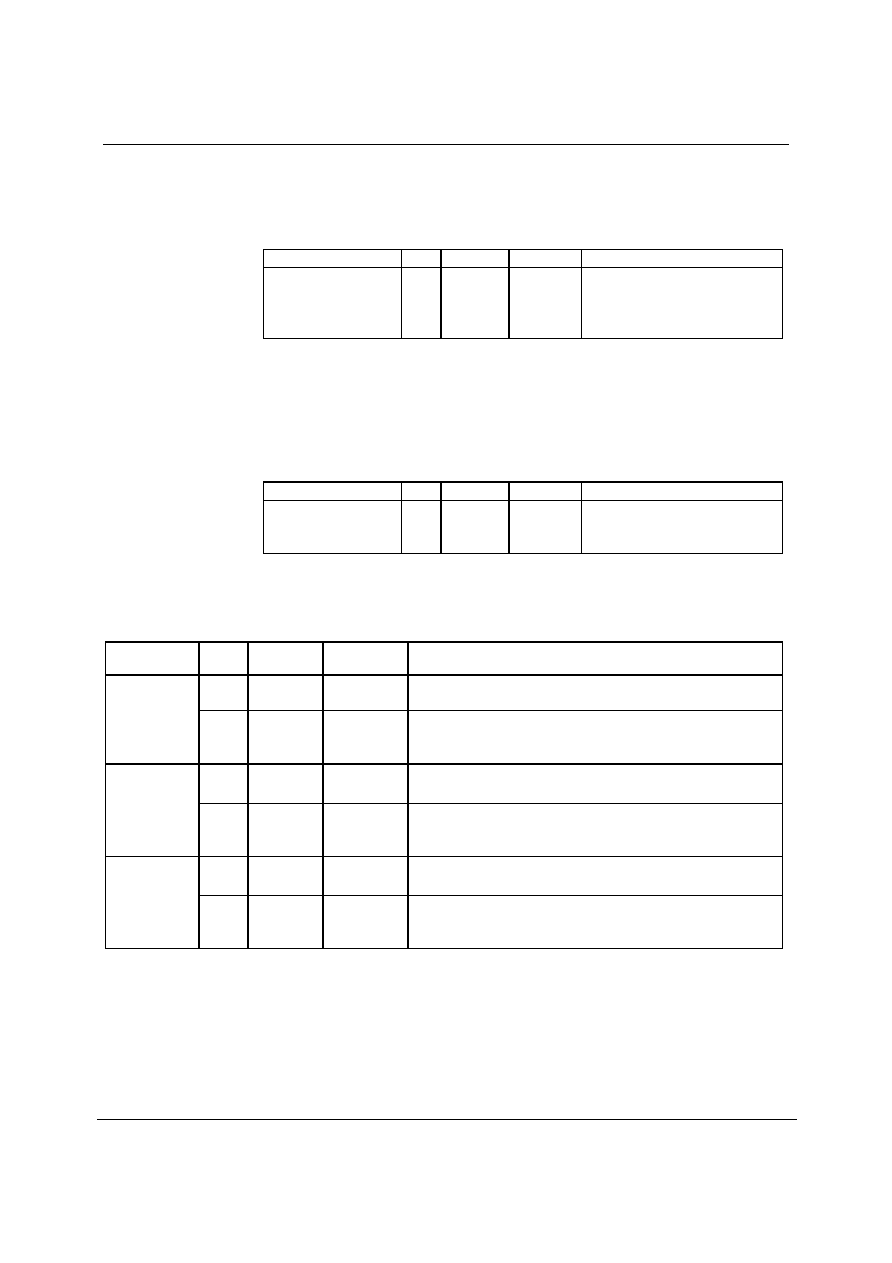
WM8569
Product Preview
w
PP Rev 1.1 December 2005
28
By default, ADCLRC and DOUT are sampled on the rising edge of ADCBCLK and should ideally
change on the falling edge. Data sources that change ADCLRC and DOUT on the rising edge of
ADCBCLK can be supported by setting the ADCBCP register bit. Setting ADCBCP to 1 inverts the
polarity of ADCBCLK to the inverse of that shown in Figure 11 to Figure 17
REGISTER ADDRESS
BIT
LABEL
DEFAULT
DESCRIPTION
0001100
Interface Control
5
ADCBCP
0
ADCBCLK Polarity (DSP Modes):
0: normal BCLK polarity
1: inverted BCLK polarity
MUTE PIN DECODE
The MUTE pin can either be used an output or an input. As an output it indicated 1024 consecutive
zero samples to the DAC. By default selecting the MUTE to represent if the DAC has received more
than 1024 midrail samples will cause the MUTE to be asserted as a softmute on the DAC. Disabling
the decode block will cause any logical high on the MUTE pin to apply a softmute to the DAC.
REGISTER ADDRESS
BIT
LABEL
DEFAULT
DESCRIPTION
0001100
ADC Control
6
MPD
0
MUTE Pin Decode Disable:
0: MUTE pin decode enable
1: MUTE pin decode disable
DAC DIGITAL VOLUME CONTROL
The DAC volume may also be adjusted in the digital domain using independent digital attenuation
control registers
REGISTER
ADDRESS
BIT
LABEL
DEFAULT
DESCRIPTION
7:0
LDA[7:0]
11111111
(0dB)
Digital Attenuation data for Left channel DACL in 0.5dB steps. See
Table 9
0000000
Digital
Attenuation
DACL
8
UPDATE
Not latched
Controls simultaneous update of all Attenuation Latches
0: Store LDA in intermediate latch (no change to output)
1: Store LDA and update attenuation on all channels
7:0
RDA[6:0]
11111111
(0dB)
Digital Attenuation data for Right channel DACR in 0.5dB steps. See
Table 9
0000001
Digital
Attenuation
DACR
8
UPDATE
Not latched
Controls simultaneous update of all Attenuation Latches
0: Store RDA in intermediate latch (no change to output)
1: Store RDA and update attenuation on all channels.
7:0
MASTDA
[7:0]
11111111
(0dB)
Digital Attenuation data for all DAC channels in 0.5dB steps. See
Table 9
0001000
Master
Digital
Attenuation
(all channels)
8
UPDATE
Not latched
Controls simultaneous update of all Attenuation Latches
0: Store gain in intermediate latch (no change to output)
1: Store gain and update attenuation on all channels.
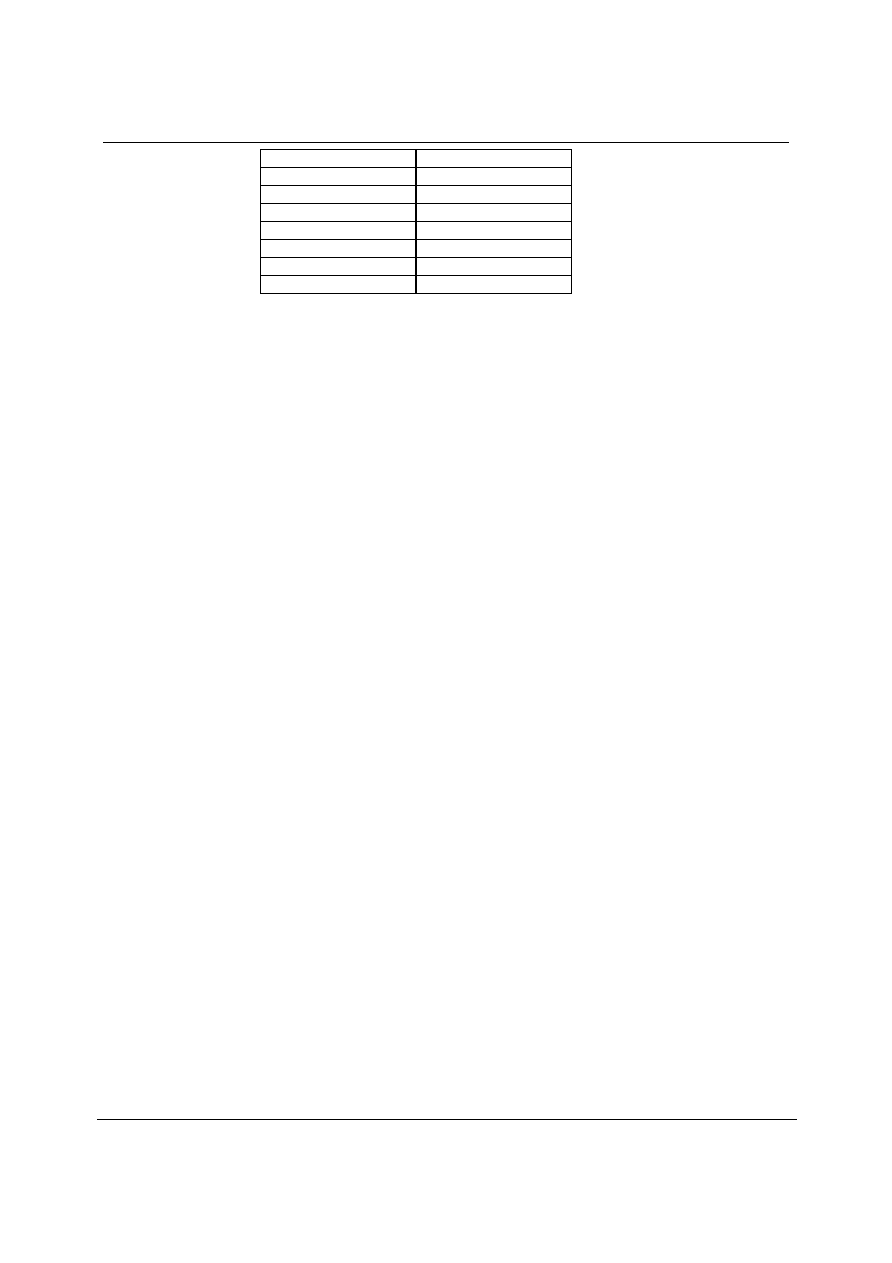
Product Preview
WM8569
w
PP Rev 1.1 December 2005
29
L/RDAX[7:0]
ATTENUATION LEVEL
00(hex)
-
dB (mute)
01(hex)
-127dB
:
:
:
:
:
:
FE(hex)
-0.5dB
FF(hex)
0dB
Table 9 Digital Volume Control Attenuation Levels
SOFTWARE REGISTER RESET
Writing to register 11111 will cause a register reset, resetting all register bits to their default values.
The device will be held in this reset state until a subsequent register write to any address is
completed.
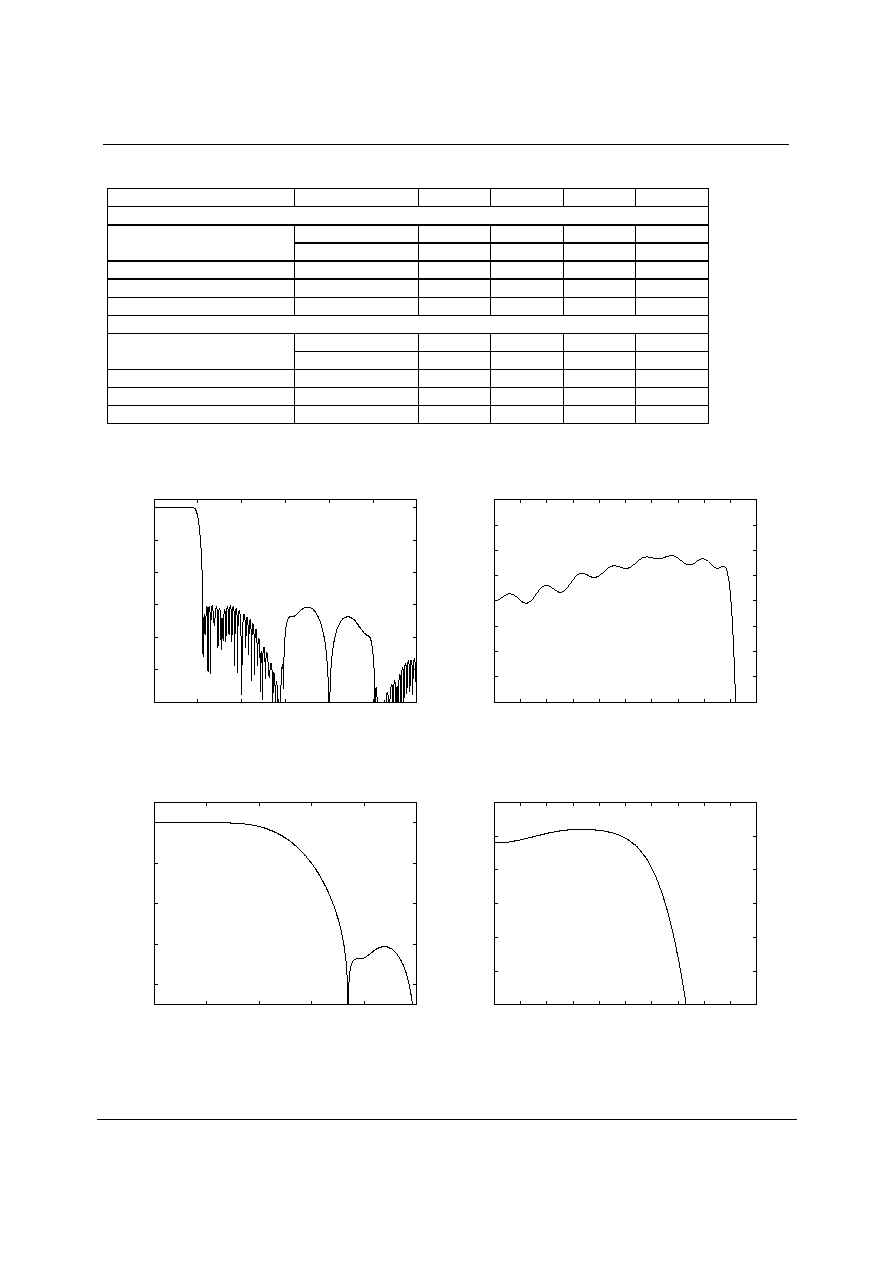
WM8569
Product Preview
w
PP Rev 1.1 December 2005
30
DIGITAL FILTER CHARACTERISTICS
PARAMETER
TEST CONDITIONS
MIN
TYP
MAX
UNIT
ADC Filter
±0.01 dB
0
0.4535fs
Passband
-6dB
0.5fs
Passband ripple
±0.01
dB
Stopband
0.5465fs
Stopband Attenuation
f > 0.5465fs
-65
dB
DAC Filter
±0.05 dB
0.444fs
Passband
-3dB
0.487fs
Passband ripple
±0.05
dB
Stopband
0.555fs
Stopband Attenuation
f > 0.555fs
-60
dB
Table 10 Digital Filter Characteristics
DAC FILTER RESPONSES
-120
-100
-80
-60
-40
-20
0
0
0.5
1
1.5
2
2.5
3
Response (dB)
Frequency (Fs)
-0.2
-0.15
-0.1
-0.05
0
0.05
0.1
0.15
0.2
0
0.05
0.1
0.15
0.2
0.25
0.3
0.35
0.4
0.45
0.5
Response (dB)
Frequency (Fs)
Figure 19 DAC Digital Filter Frequency Response
≠ 44.1, 48 and 96kHz
Figure 20 DAC Digital Filter Ripple ≠44.1, 48 and 96kHz
-80
-60
-40
-20
0
0
0.2
0.4
0.6
0.8
1
Response (dB)
Frequency (Fs)
-1
-0.8
-0.6
-0.4
-0.2
0
0.2
0
0.05
0.1
0.15
0.2
0.25
0.3
0.35
0.4
0.45
0.5
Response (dB)
Frequency (Fs)
Figure 21 DAC Digital Filter Frequency Response
≠ 192kHz
Figure 22 DAC Digital Filter Ripple ≠ 192kHz
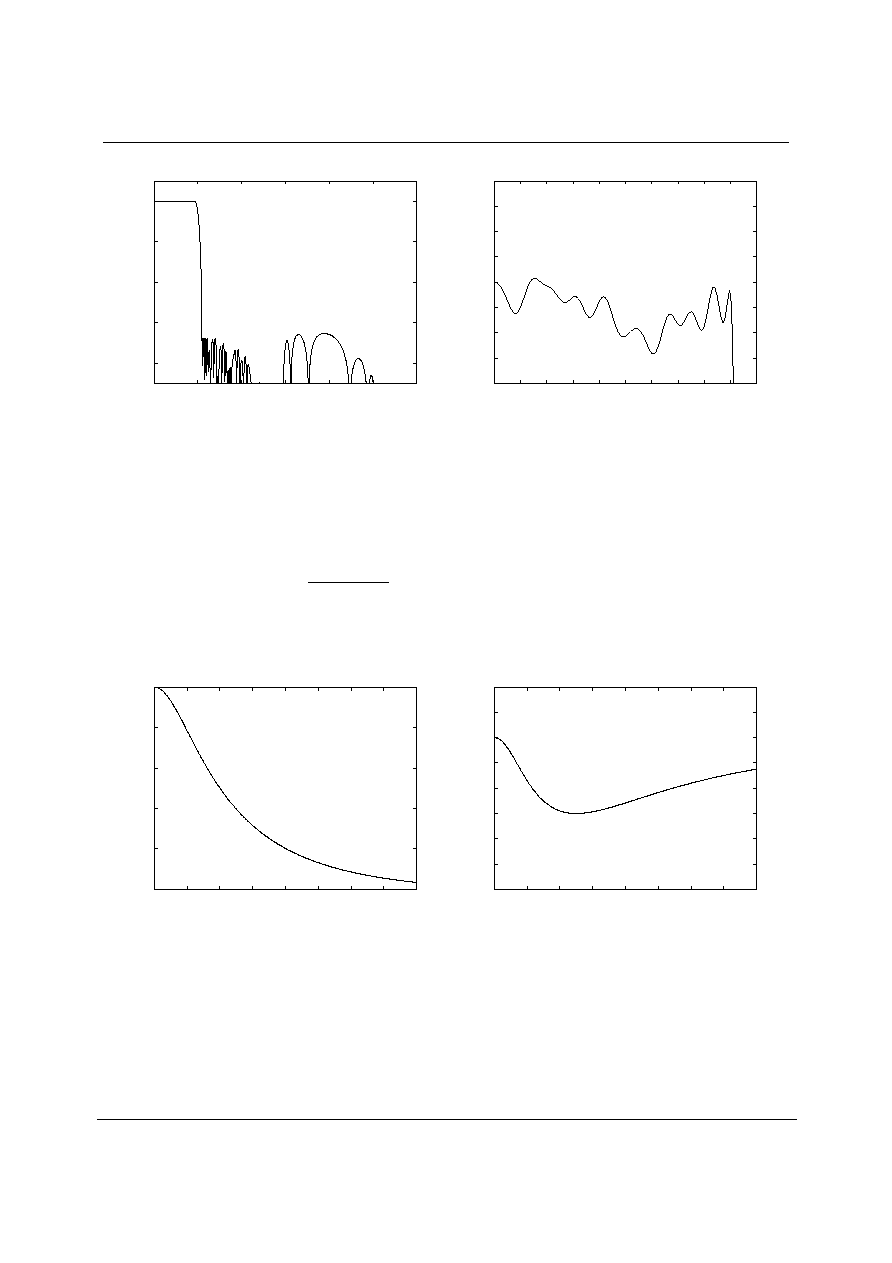
Product Preview
WM8569
w
PP Rev 1.1 December 2005
31
ADC FILTER RESPONSES
-80
-60
-40
-20
0
0
0.5
1
1.5
2
2.5
3
Response (dB)
Frequency (Fs)
-0.02
-0.015
-0.01
-0.005
0
0.005
0.01
0.015
0.02
0
0.05
0.1
0.15
0.2
0.25
0.3
0.35
0.4
0.45
0.5
Response (dB)
Frequency (Fs)
Figure 23 ADC Digital Filter Frequency Response
Figure 24 ADC Digital Filter Ripple
ADC HIGH PASS FILTER
The WM8569 has a selectable digital high pass filter to remove DC offsets. The filter response is characterised by the
following polynomial.
1
1
9995
.
0
1
1
)
(
-
-
-
-
=
z
z
z
H
DIGITAL DE-EMPHASIS CHARACTERISTICS
-10
-8
-6
-4
-2
0
0
2
4
6
8
10
12
14
16
Response (dB)
Frequency (kHz)
-3
-2.5
-2
-1.5
-1
-0.5
0
0.5
1
0
2
4
6
8
10
12
14
16
Response (dB)
Frequency (kHz)
Figure 25 De-Emphasis Frequency Response (32kHz)
Figure 26 De-Emphasis Error (32kHz)
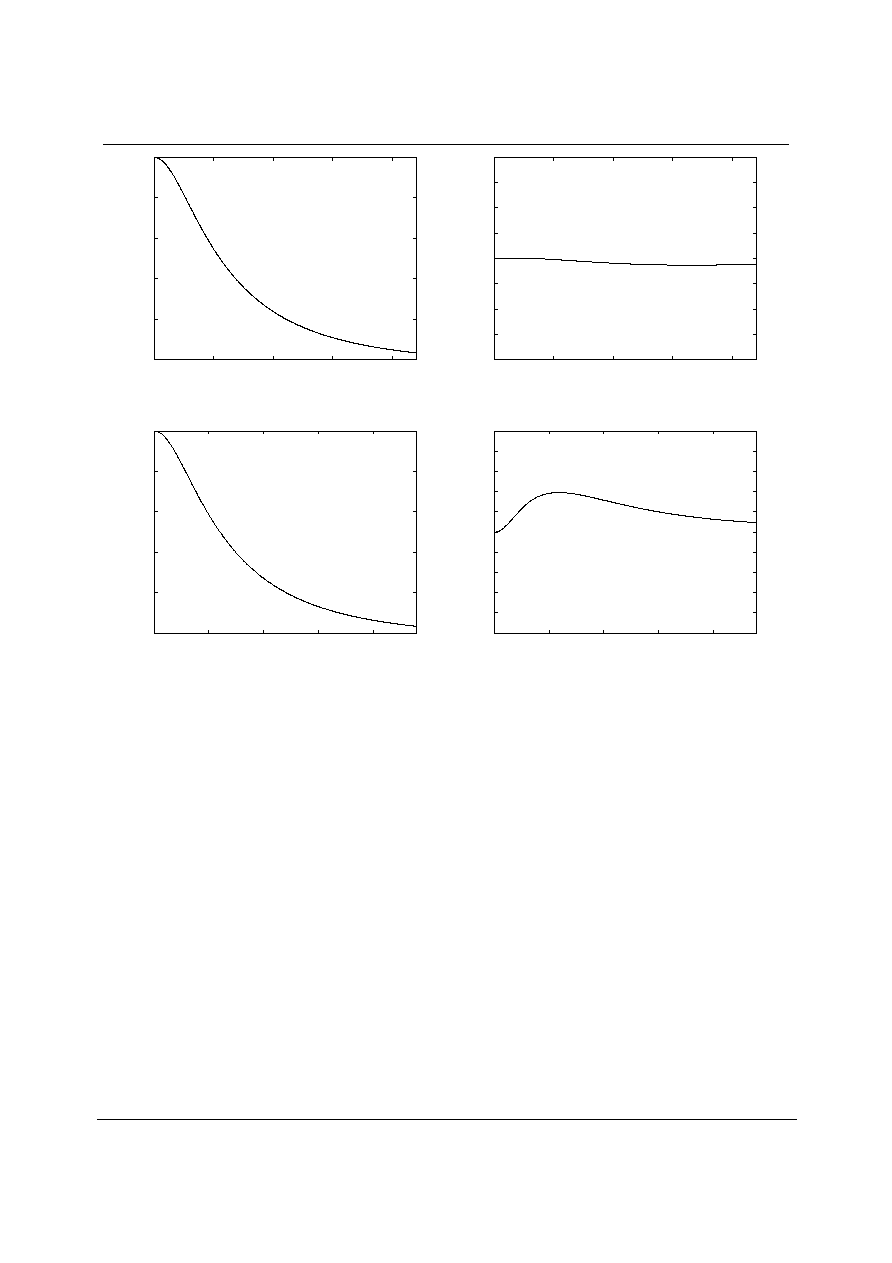
WM8569
Product Preview
w
PP Rev 1.1 December 2005
32
-10
-8
-6
-4
-2
0
0
5
10
15
20
Response (dB)
Frequency (kHz)
-0.4
-0.3
-0.2
-0.1
0
0.1
0.2
0.3
0.4
0
5
10
15
20
Response (dB)
Frequency (kHz)
Figure 27 De-Emphasis Frequency Response (44.1kHz)
Figure 28 De-Emphasis Error (44.1kHz)
-10
-8
-6
-4
-2
0
0
5
10
15
20
Response (dB)
Frequency (kHz)
-1
-0.8
-0.6
-0.4
-0.2
0
0.2
0.4
0.6
0.8
1
0
5
10
15
20
Response (dB)
Frequency (kHz)
Figure 29 De-Emphasis Frequency Response (48kHz)
Figure 30 De-Emphasis Error (48kHz)

Product Preview
WM8569
w
PP Rev 1.1 December 2005
33
APPLICATIONS INFORMATION
RECOMMENDED EXTERNAL COMPONENTS
Figure 31 Recommended External Components Diagram
RECOMMENDED EXTERNAL COMPONENTS VALUES
COMPONENT
REFERENCE
SUGGESTED
VALUE
DESCRIPTION
C1 and C5
10
µF
De-coupling for DVDD and AVDD.
C2 to C4
0.1
µF
De-coupling for DVDD and AVDD.
C8 and C9
1
µF
Analogue input high pass filter capacitors
C6 and C10
0.1
µF
C7 and C11
10
µF
Reference de-coupling capacitors for VMID and ADCREF pin.
C12
10
µF
Filtering for VREFP. Omit if AVDD low noise.
R1
33
Filtering for VREP. Use 0
if AVDD low noise.
Table 11 Recommended External Components Description
Note: Further details for filtering on reference pins are available in Wolfson Application Note WAN0144.

WM8569
Product Preview
w
PP Rev 1.1 December 2005
34
SUGGESTED ANALOGUE LOW PASS POST DAC FILTERS
It is recommended that a lowpass filter be applied to the output from each DAC channel for Hi Fi applications. Typically a
second order filter is suitable and provides sufficient attenuation of high frequency components (the unique low order, high
bit count multi-bit sigma delta DAC structure used in WM8569 produces much less high frequency output noise than
normal sigma delta DACs. This filter is typically also used to provide the 2x gain needed to provide the standard 2Vrms
output level from most consumer equipment.
Wolfson Application Note WAN0171 provides details of suitable post-DAC filter circuits.
Figure 32 Recommended Post DAC Filter Circuit

Product Preview
WM8569
w
PP Rev 1.1 December 2005
35
PACKAGE DIMENSIONS
NOTES:
A. ALL LINEAR DIMENSIONS ARE IN MILLIMETERS.
B. THIS DRAWING IS SUBJECT TO CHANGE WITHOUT NOTICE.
C. BODY DIMENSIONS DO NOT INCLUDE MOLD FLASH OR PROTRUSION, NOT TO EXCEED 0.20MM.
D. MEETS JEDEC.95 MO-150, VARIATION = AH. REFER TO THIS SPECIFICATION FOR FURTHER DETAILS.
DM007.E
DS: 28 PIN SSOP (10.2 x 5.3 x 1.75 mm)
Symbols
Dimensions
(mm)
MIN
NOM
MAX
A
-----
-----
2.0
A
1
0.05
-----
0.25
A
2
1.65
1.75
1.85
b
0.22
0.30
0.38
c
0.09
-----
0.25
D
9.90
10.20
10.50
e
E
7.40
7.80
8.20
5.00
5.30
5.60
L
0.55
0.75
0.95
A A2
A1
14
1
15
28
E1
E
c
L
GAUGE
PLANE
0.25
e
b
D
SEATING PLANE
-C-
0.10 C
REF:
JEDEC.95, MO-150
E
1
L
1
1.25 REF
0.65 BSC
L
1
0
o
4
o
8
o

WM8569
Product Preview
w
PP Rev 1.1 December 2005
36
IMPORTANT NOTICE
Wolfson Microelectronics plc (WM) reserve the right to make changes to their products or to discontinue any product or
service without notice, and advise customers to obtain the latest version of relevant information to verify, before placing
orders, that information being relied on is current. All products are sold subject to the WM terms and conditions of sale
supplied at the time of order acknowledgement, including those pertaining to warranty, patent infringement, and limitation
of liability.
WM warrants performance of its products to the specifications applicable at the time of sale in accordance with WM's
standard warranty. Testing and other quality control techniques are utilised to the extent WM deems necessary to support
this warranty. Specific testing of all parameters of each device is not necessarily performed, except those mandated by
government requirements.
In order to minimise risks associated with customer applications, adequate design and operating safeguards must be used
by the customer to minimise inherent or procedural hazards. Wolfson products are not authorised for use as critical
components in life support devices or systems without the express written approval of an officer of the company. Life
support devices or systems are devices or systems that are intended for surgical implant into the body, or support or
sustain life, and whose failure to perform when properly used in accordance with instructions for use provided, can be
reasonably expected to result in a significant injury to the user. A critical component is any component of a life support
device or system whose failure to perform can be reasonably expected to cause the failure of the life support device or
system, or to affect its safety or effectiveness.
WM assumes no liability for applications assistance or customer product design. WM does not warrant or represent that
any license, either express or implied, is granted under any patent right, copyright, mask work right, or other intellectual
property right of WM covering or relating to any combination, machine, or process in which such products or services might
be or are used. WM's publication of information regarding any third party's products or services does not constitute WM's
approval, license, warranty or endorsement thereof.
Reproduction of information from the WM web site or datasheets is permissible only if reproduction is without alteration and
is accompanied by all associated warranties, conditions, limitations and notices. Representation or reproduction of this
information with alteration voids all warranties provided for an associated WM product or service, is an unfair and deceptive
business practice, and WM is not responsible nor liable for any such use.
Resale of WM's products or services with statements different from or beyond the parameters stated by WM for that
product or service voids all express and any implied warranties for the associated WM product or service, is an unfair and
deceptive business practice, and WM is not responsible nor liable for any such use.
ADDRESS:
Wolfson Microelectronics plc
26 Westfield Road
Edinburgh
EH11 2QB
United Kingdom
Tel :: +44 (0)131 272 7000
Fax :: +44 (0)131 272 7001
Email ::
sales@wolfsonmicro.com



































